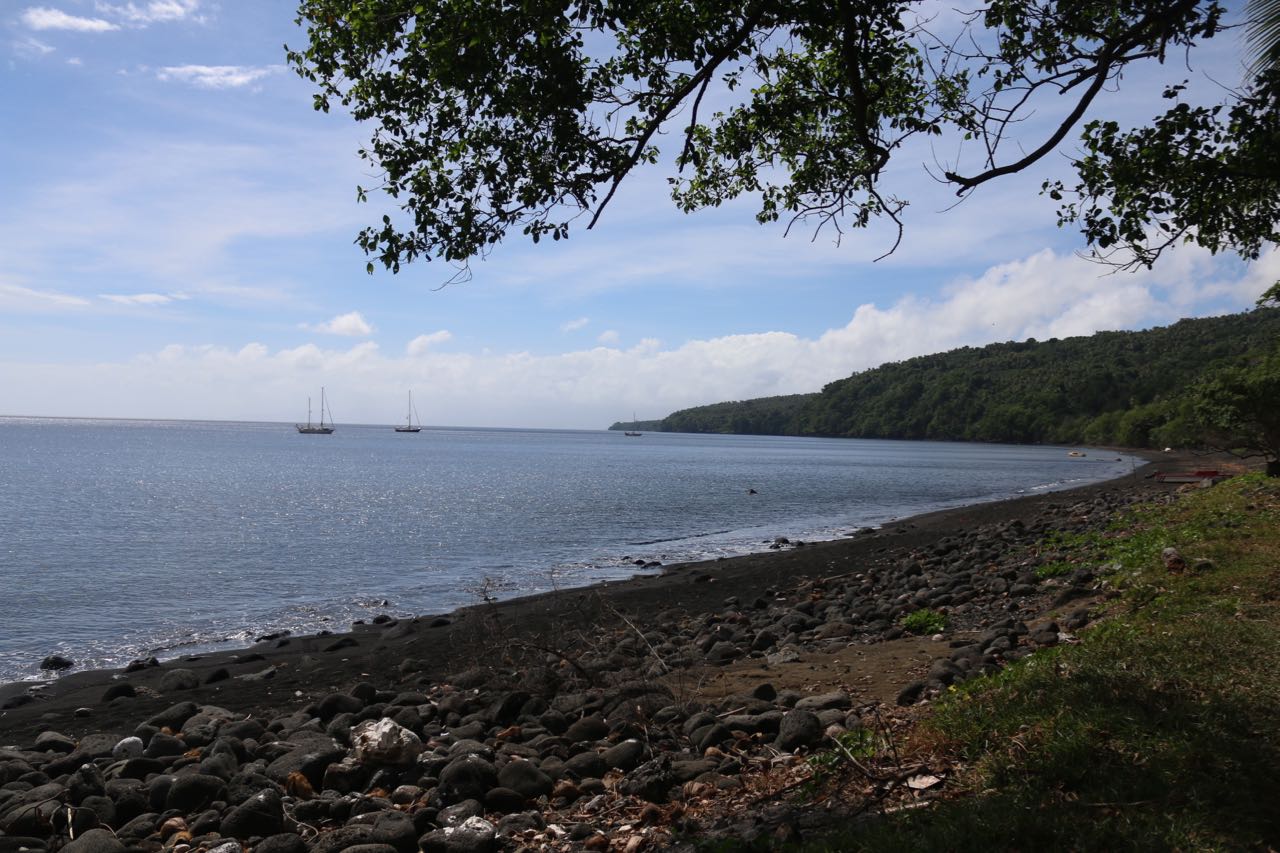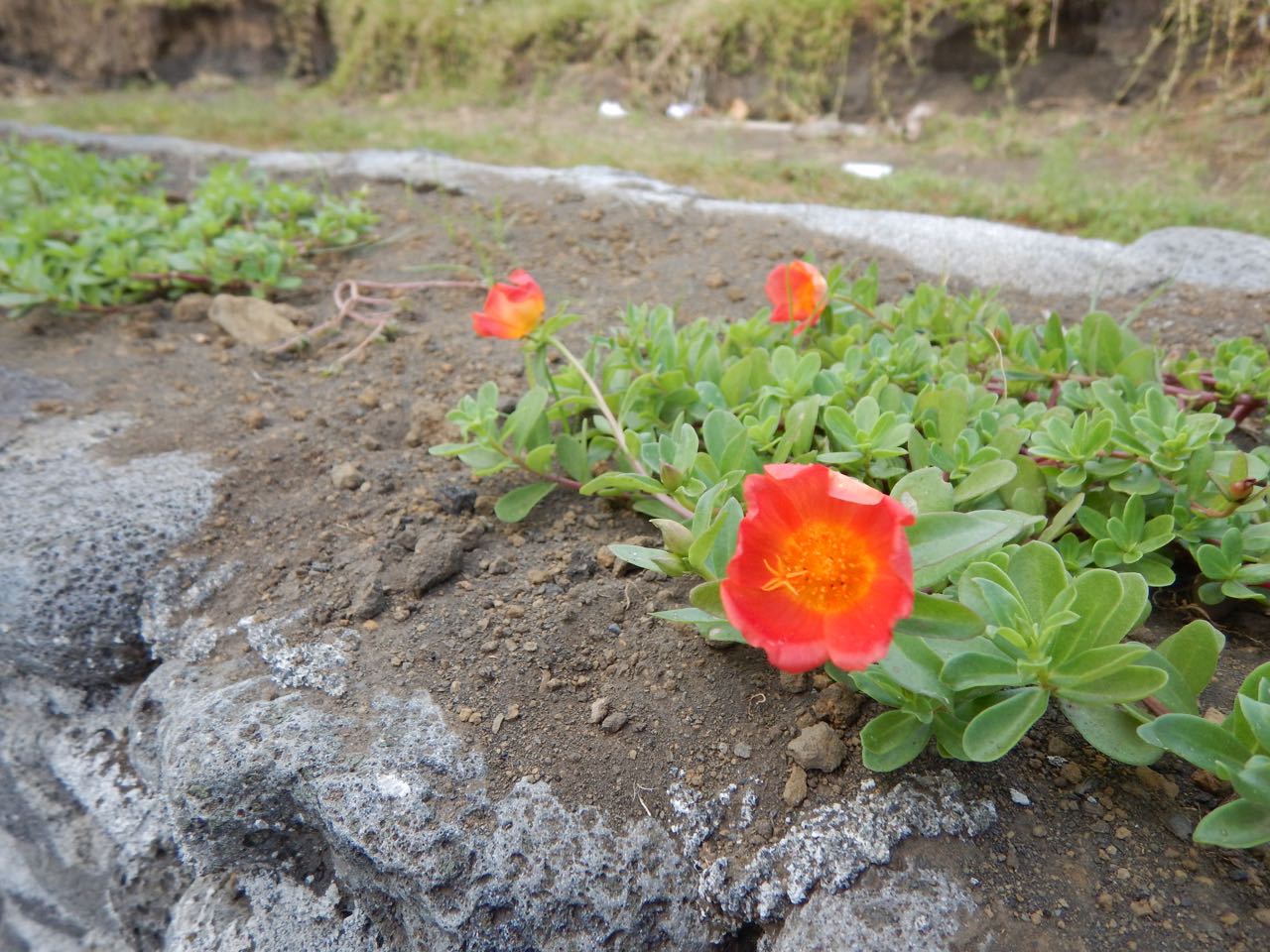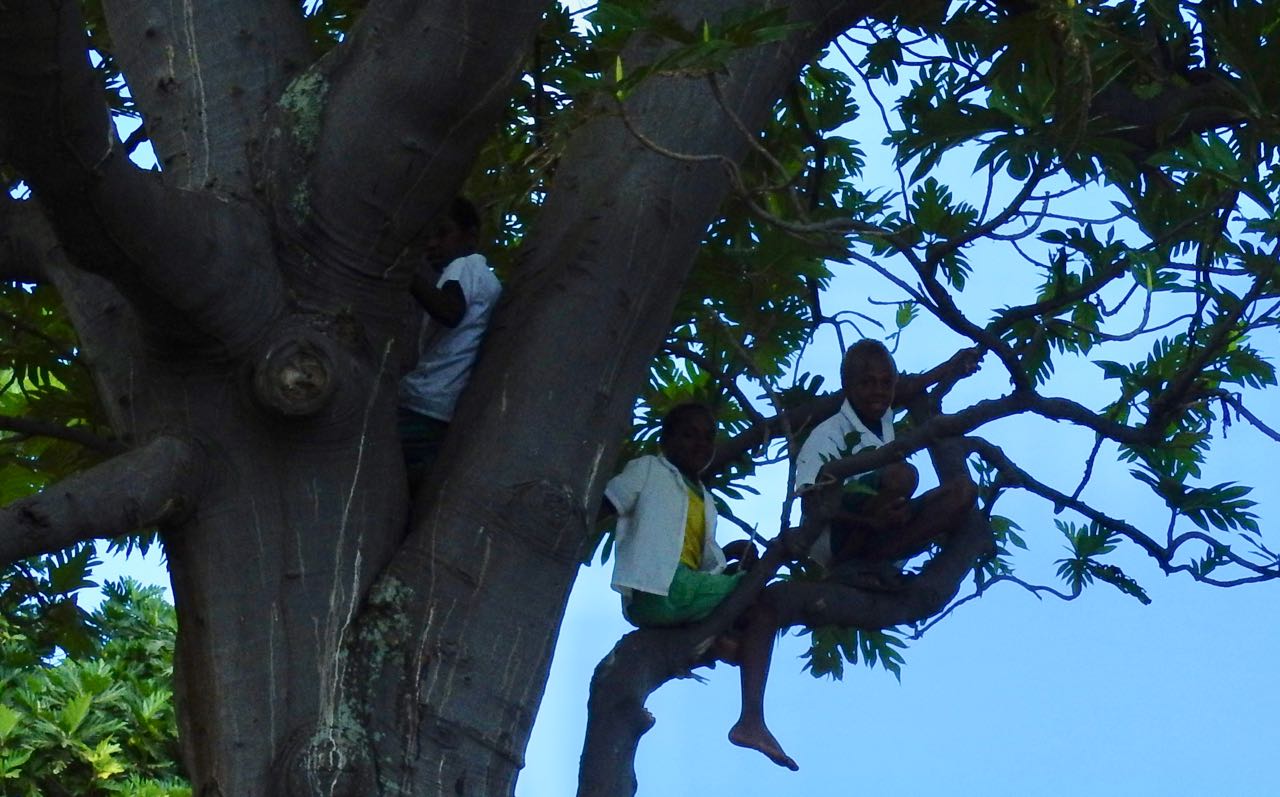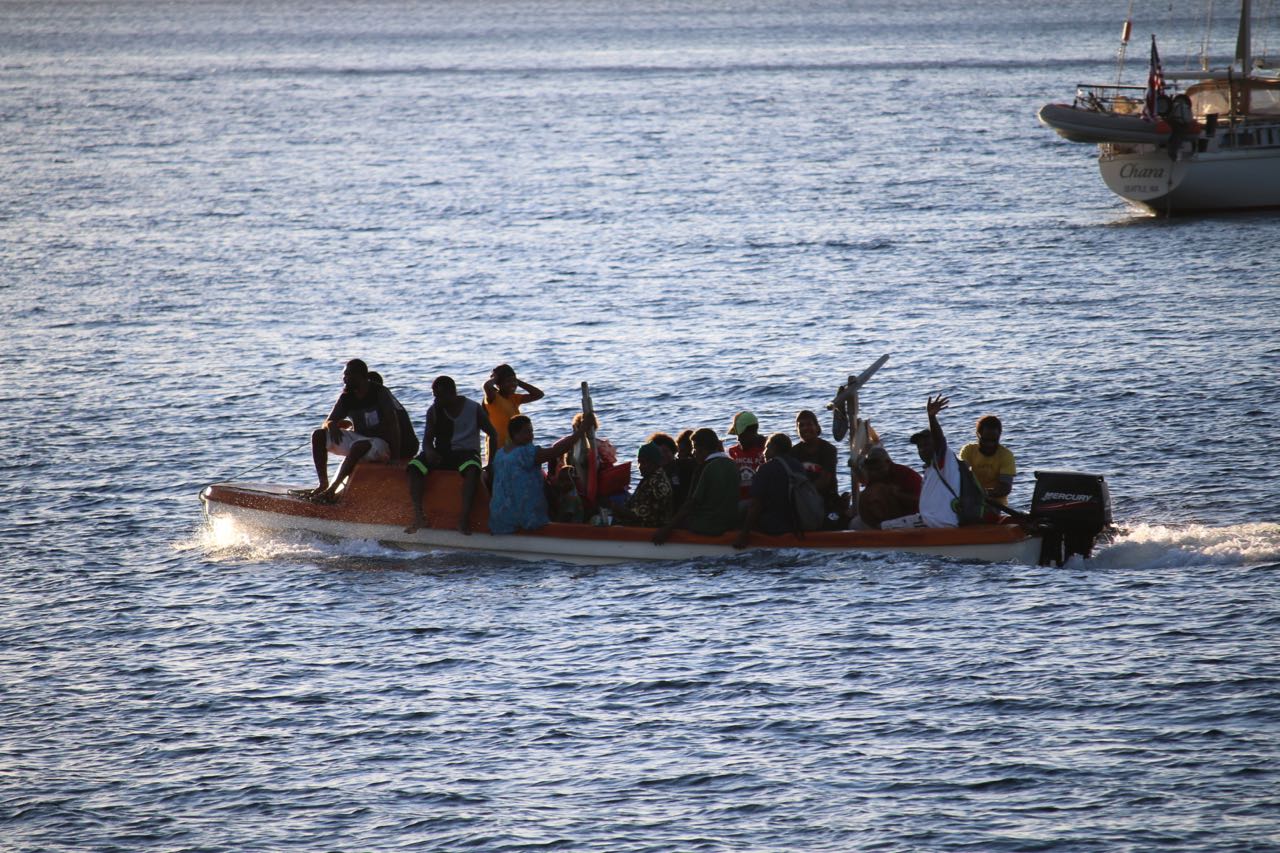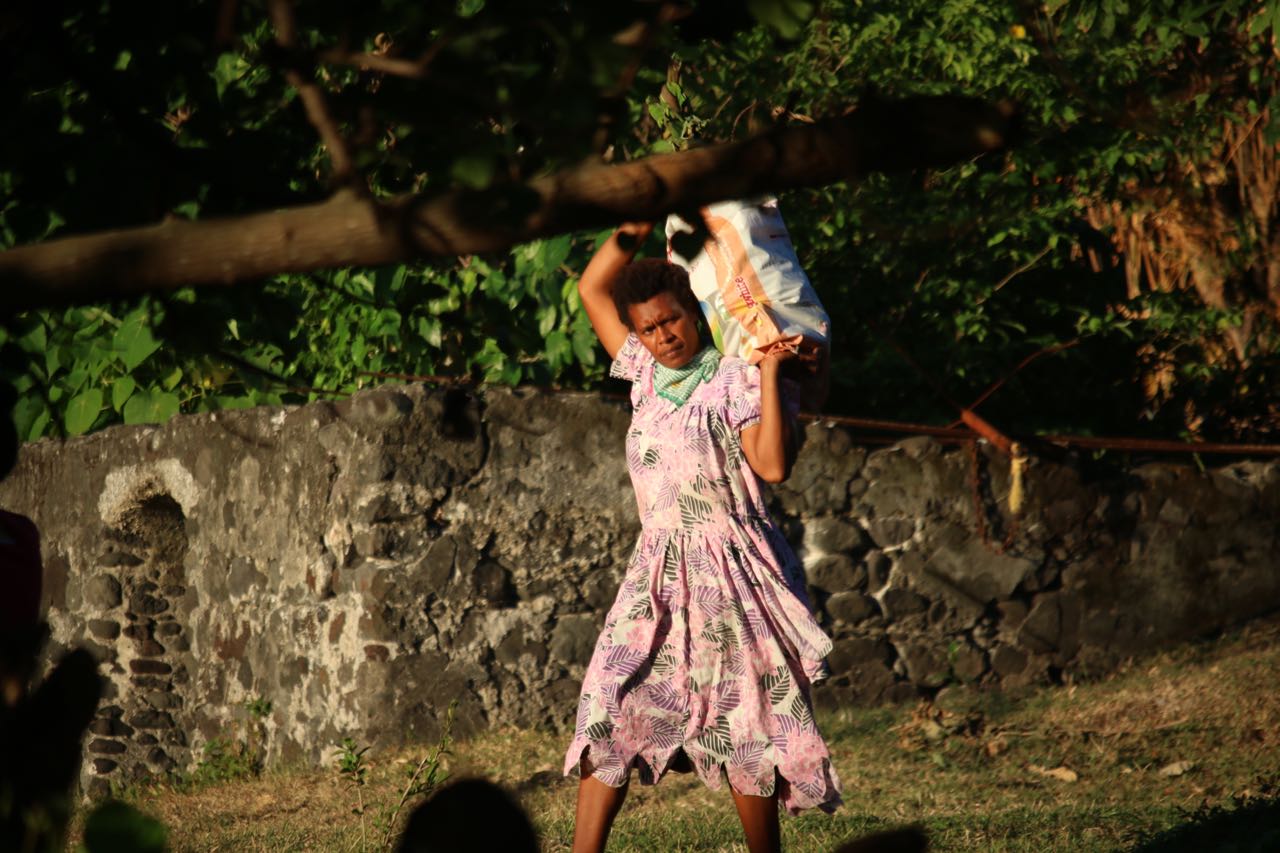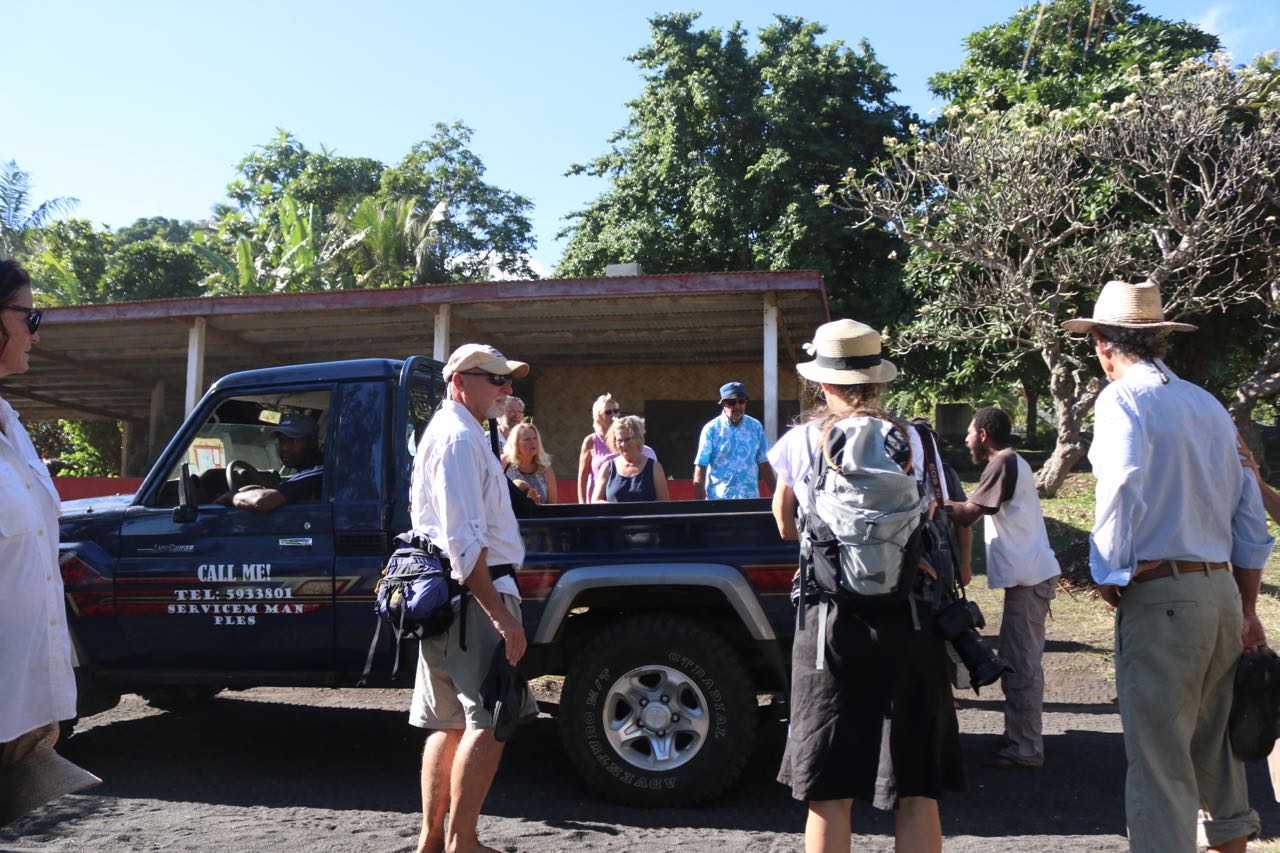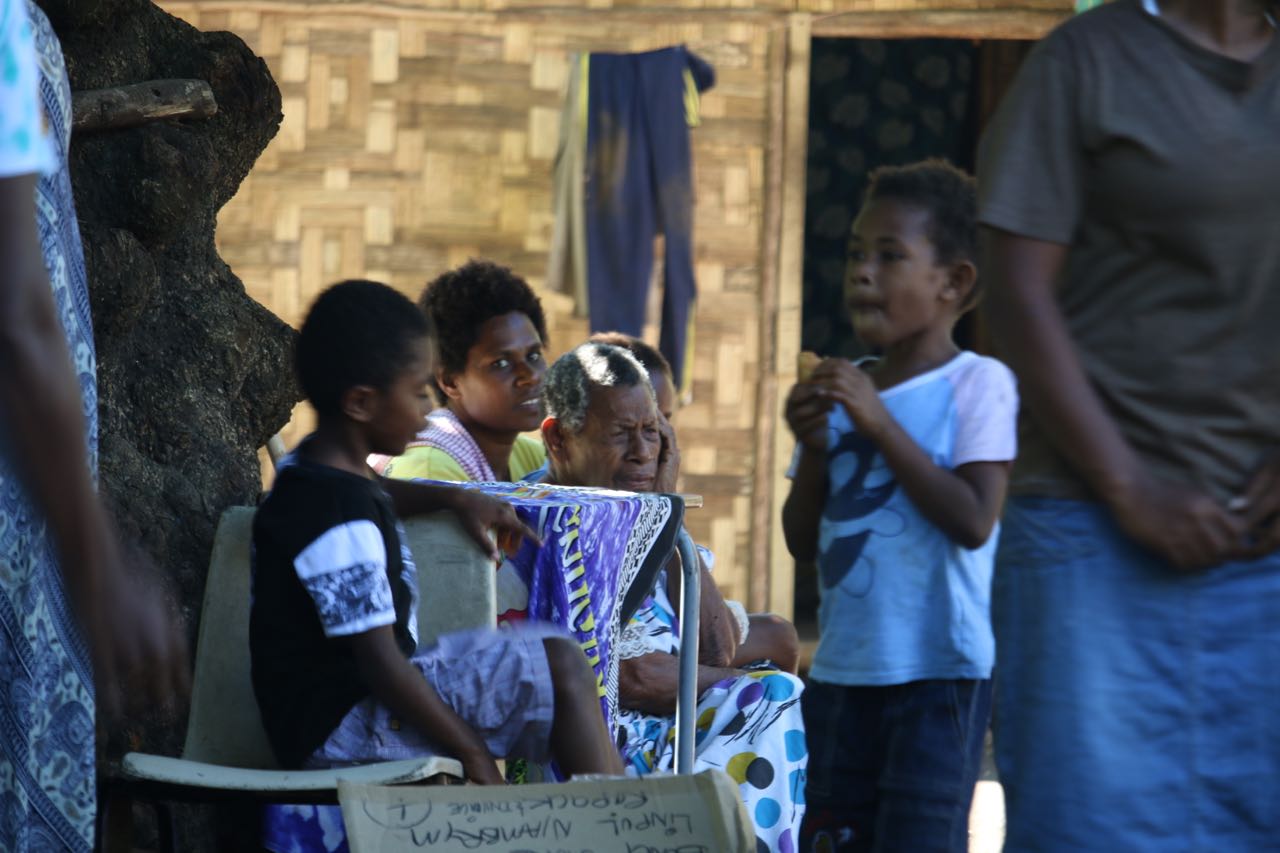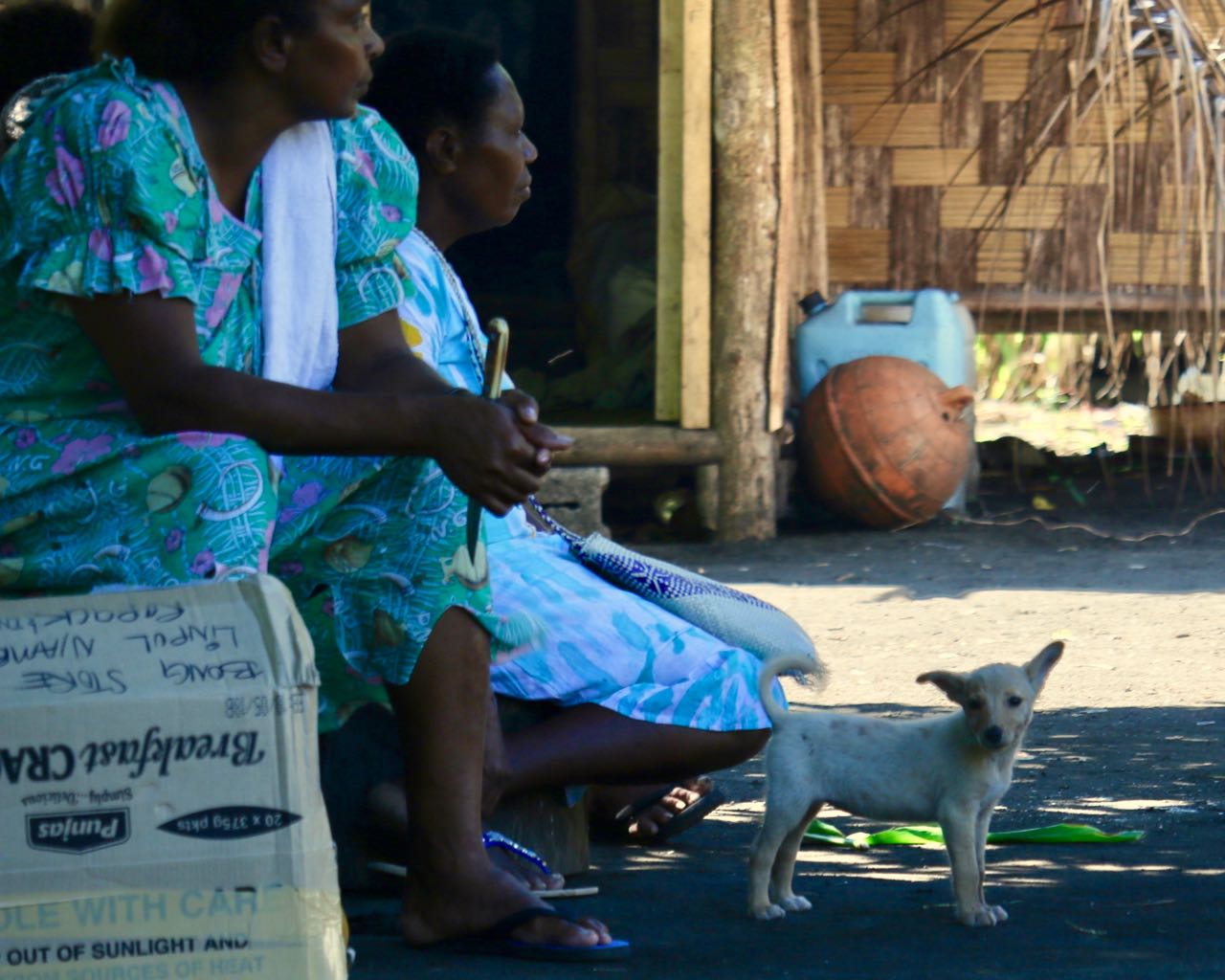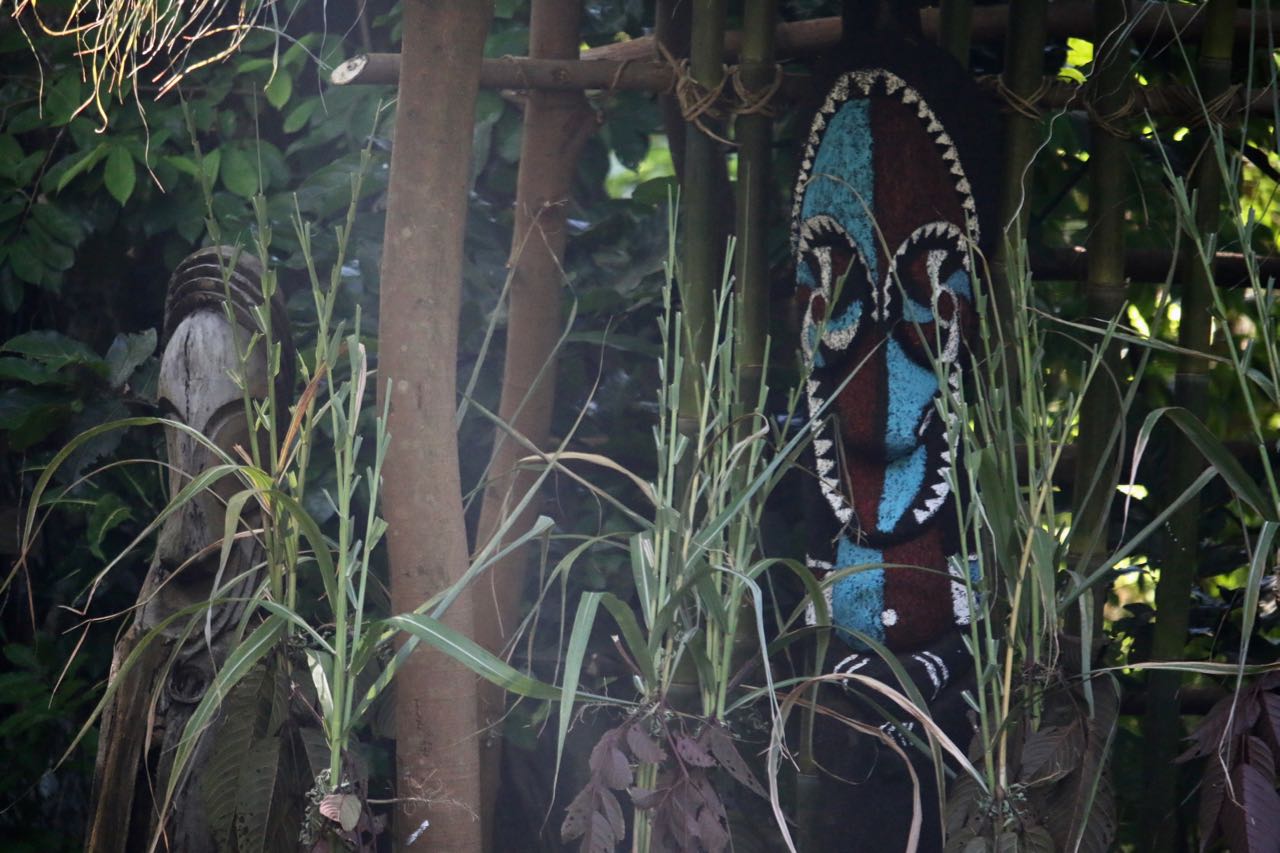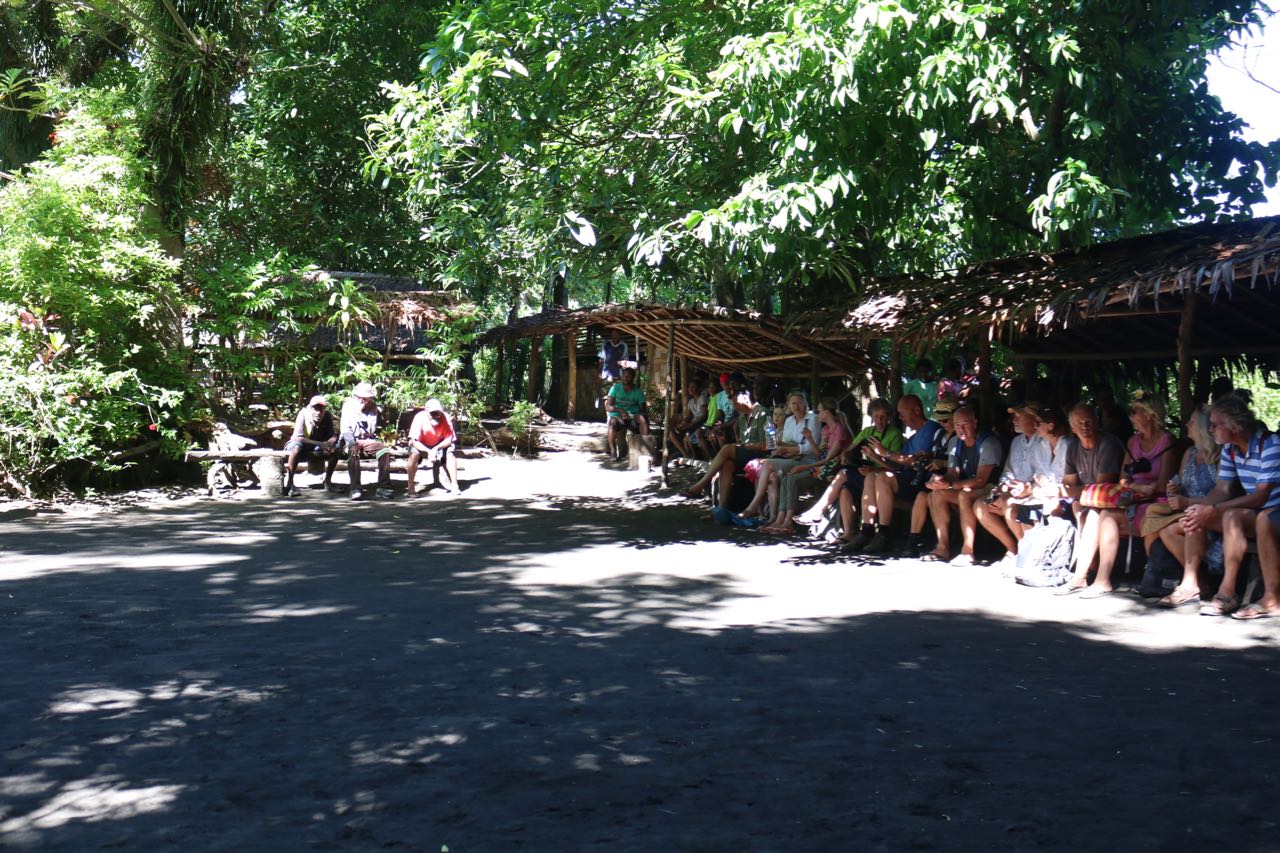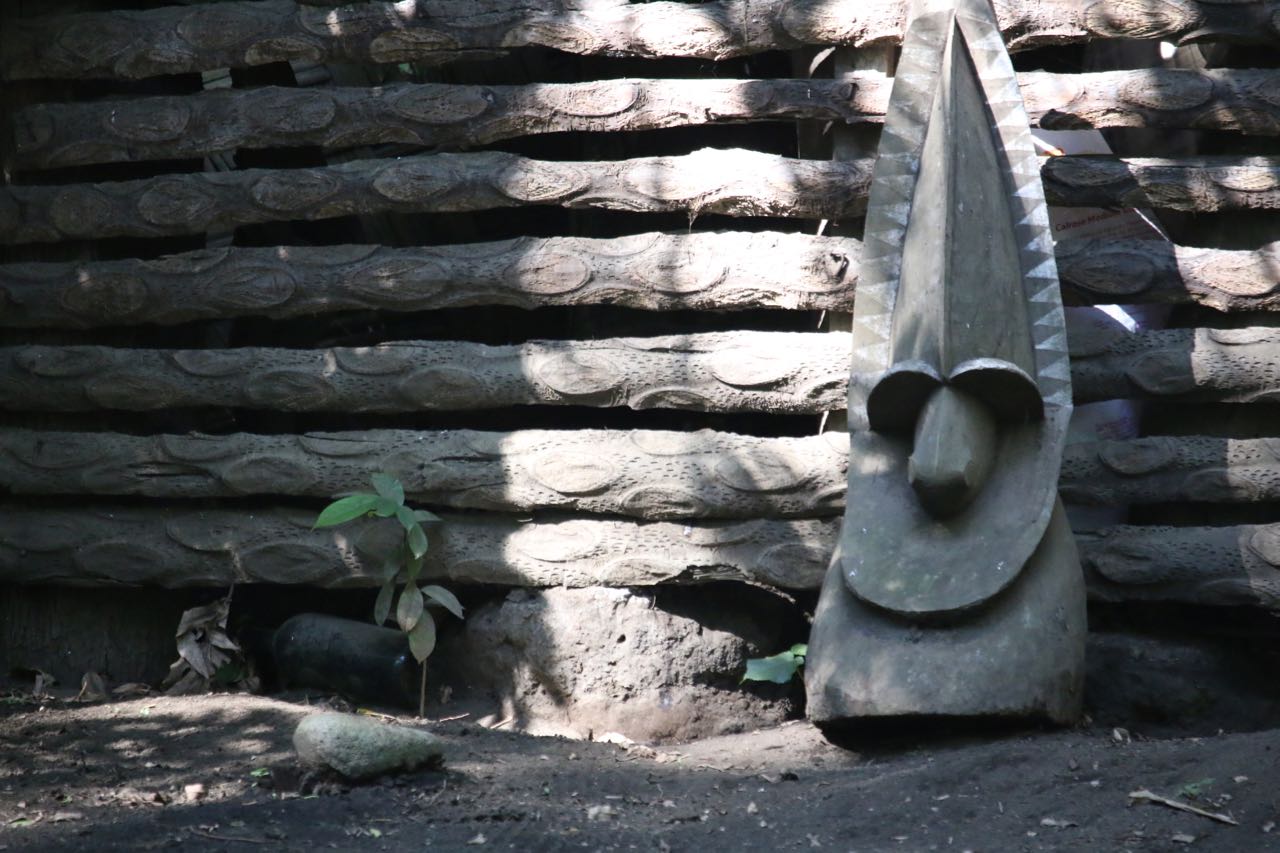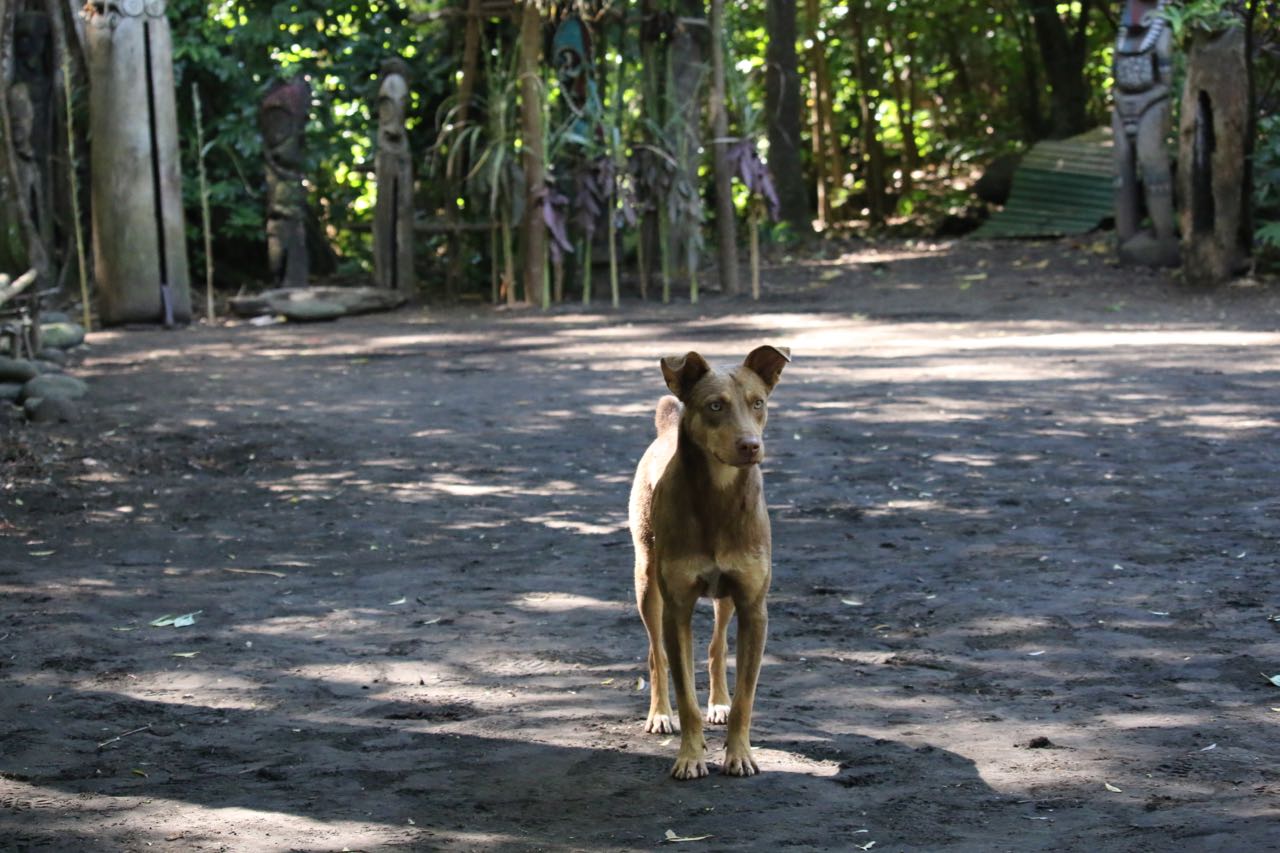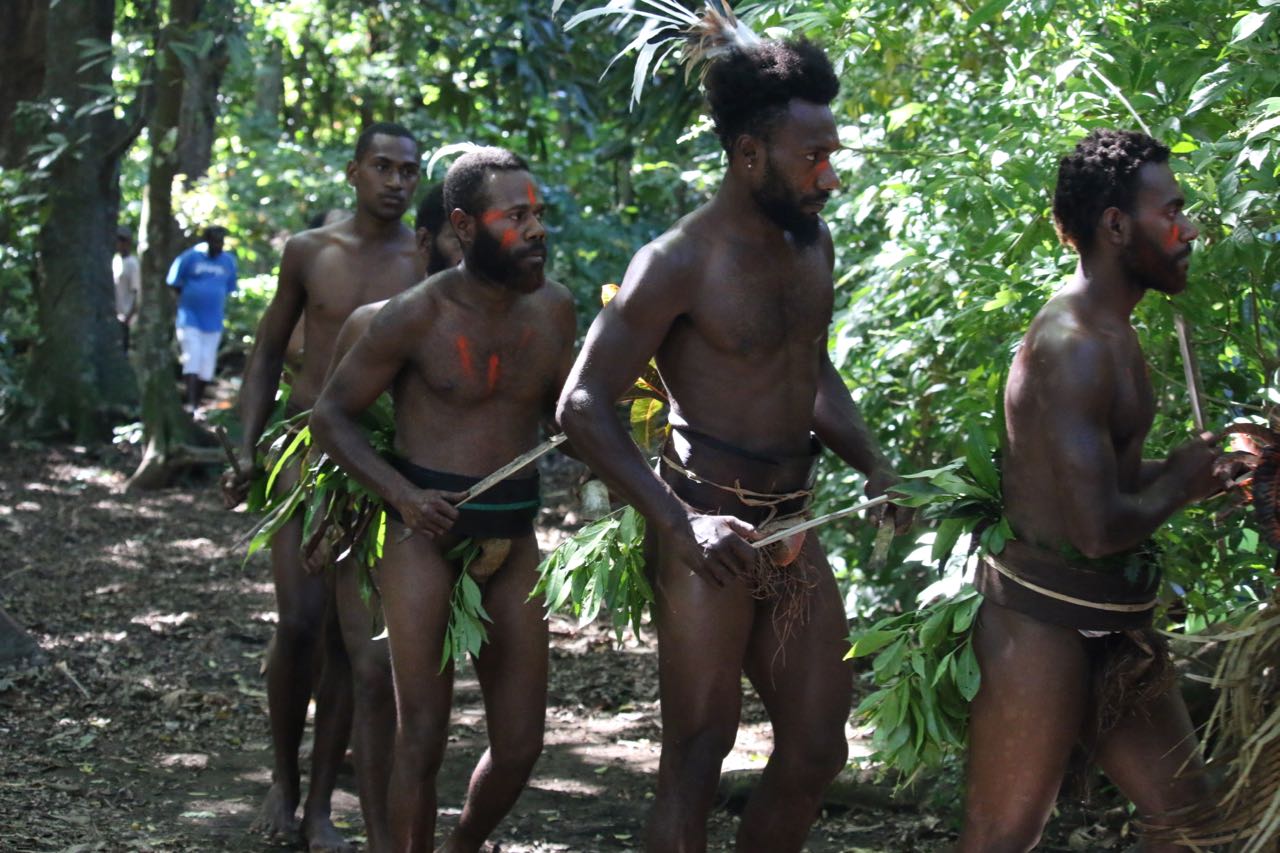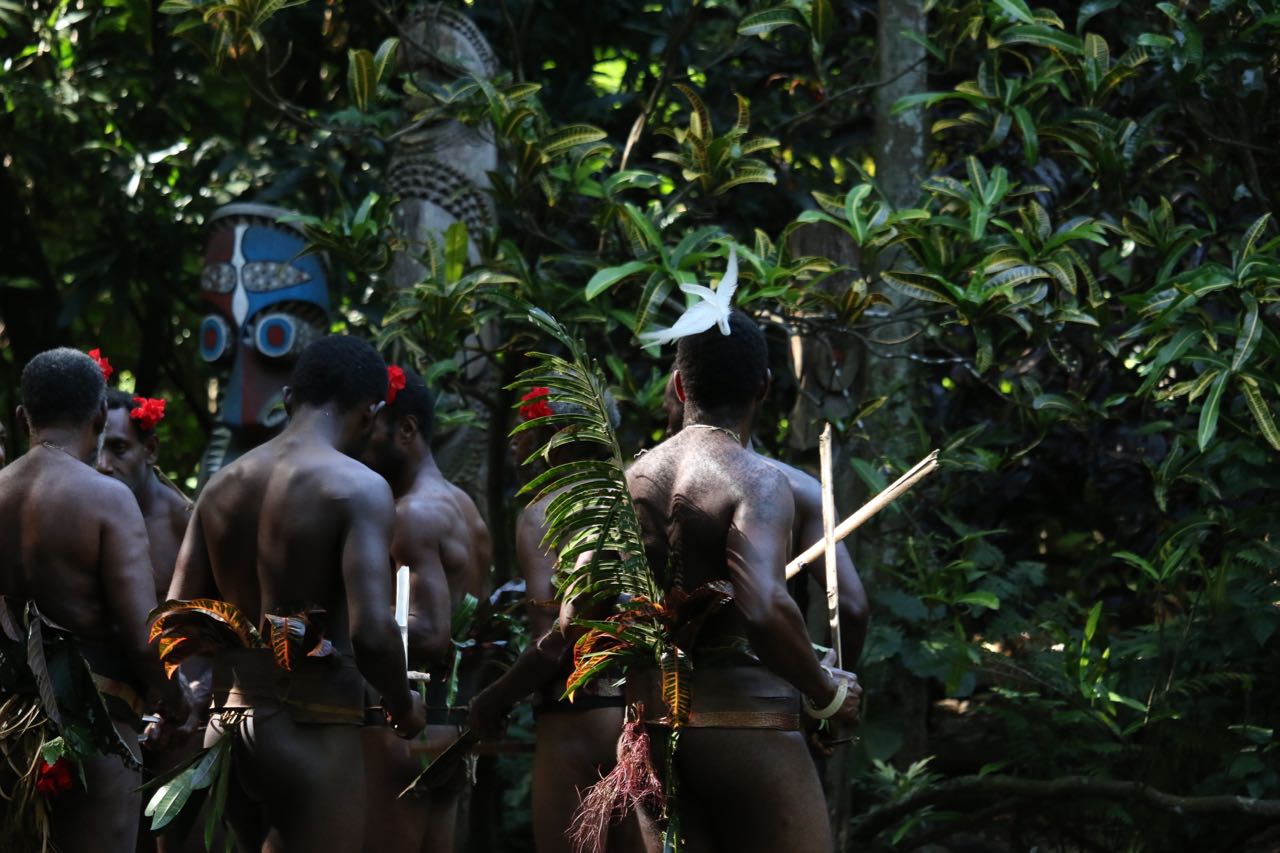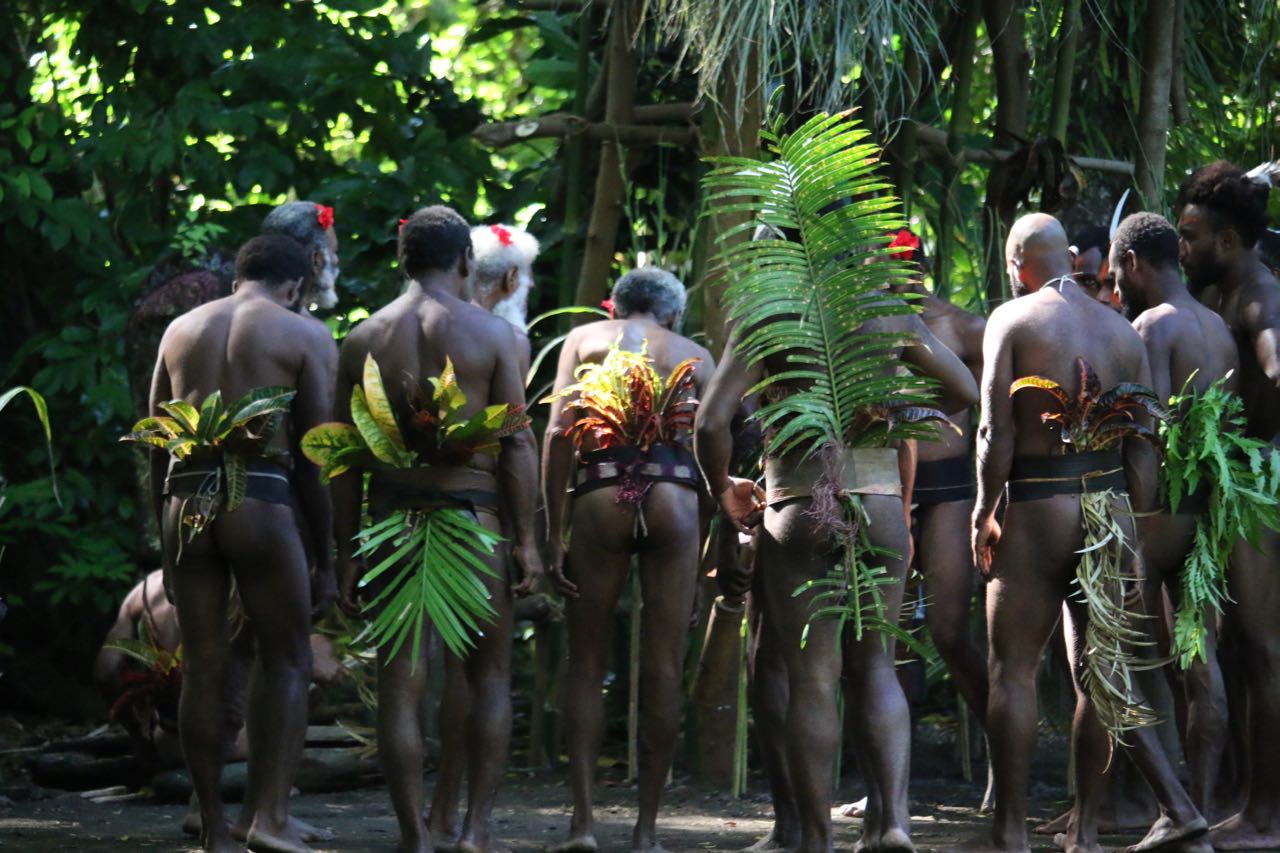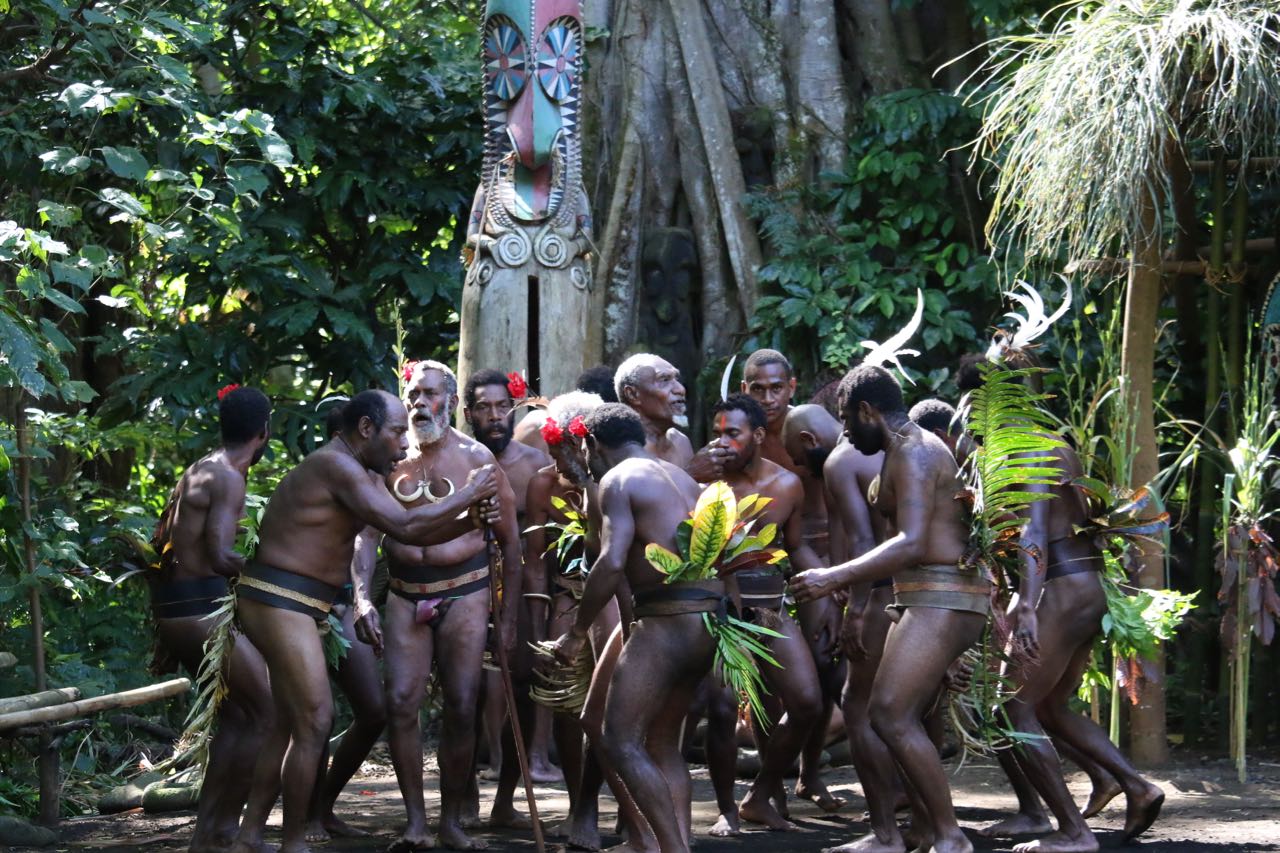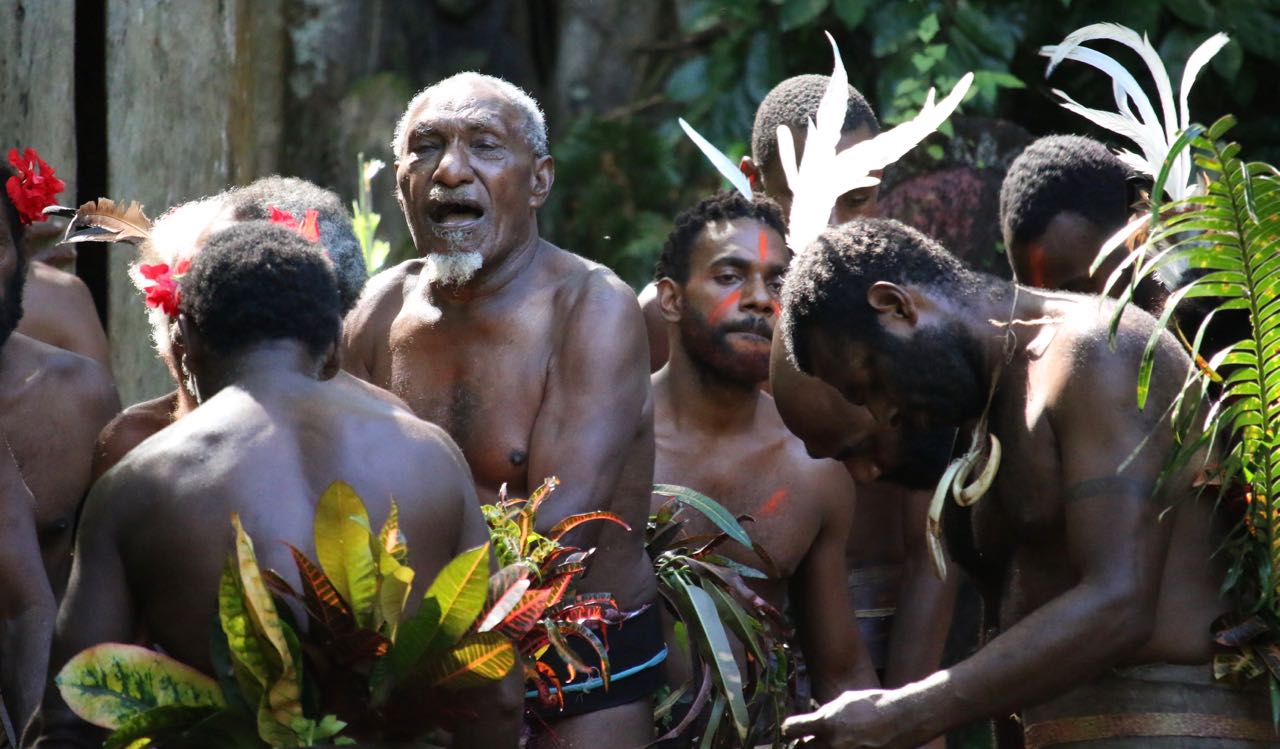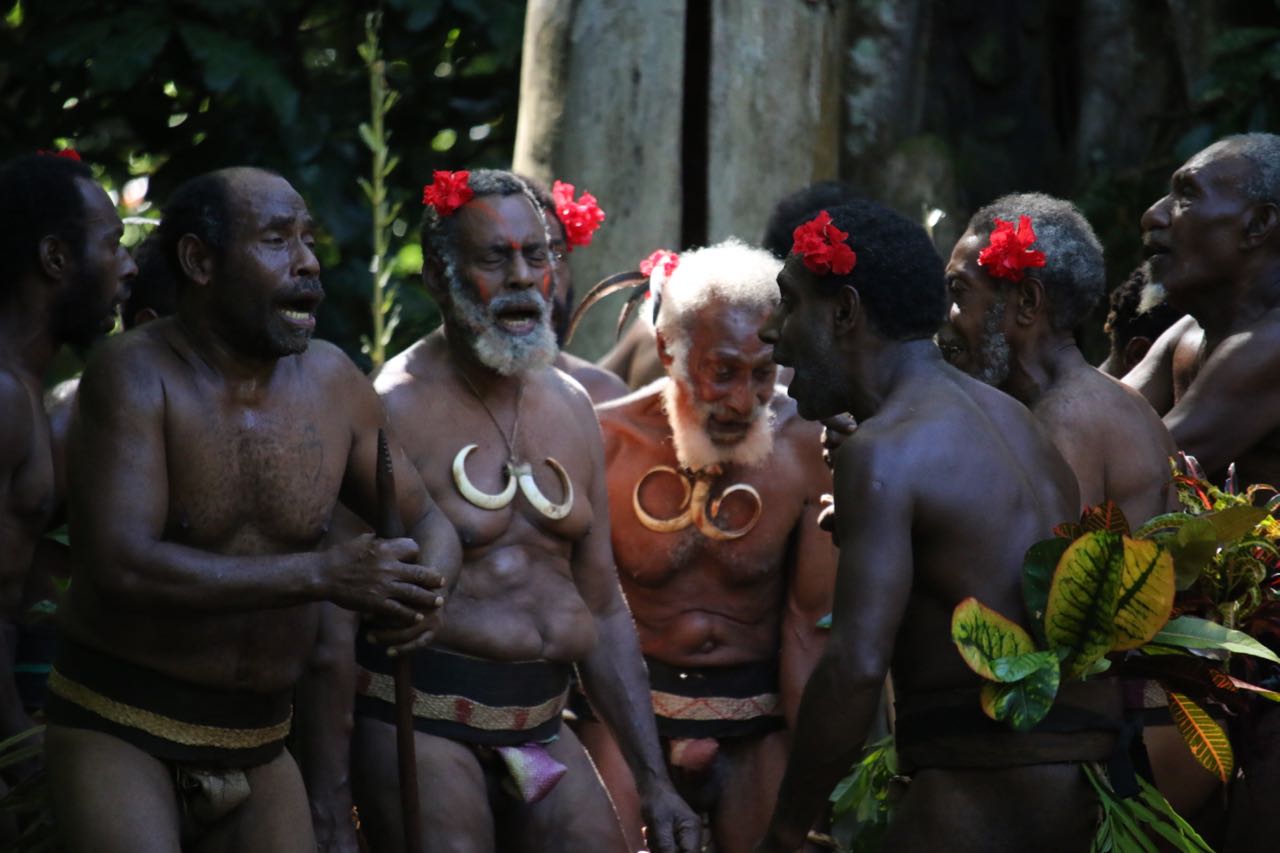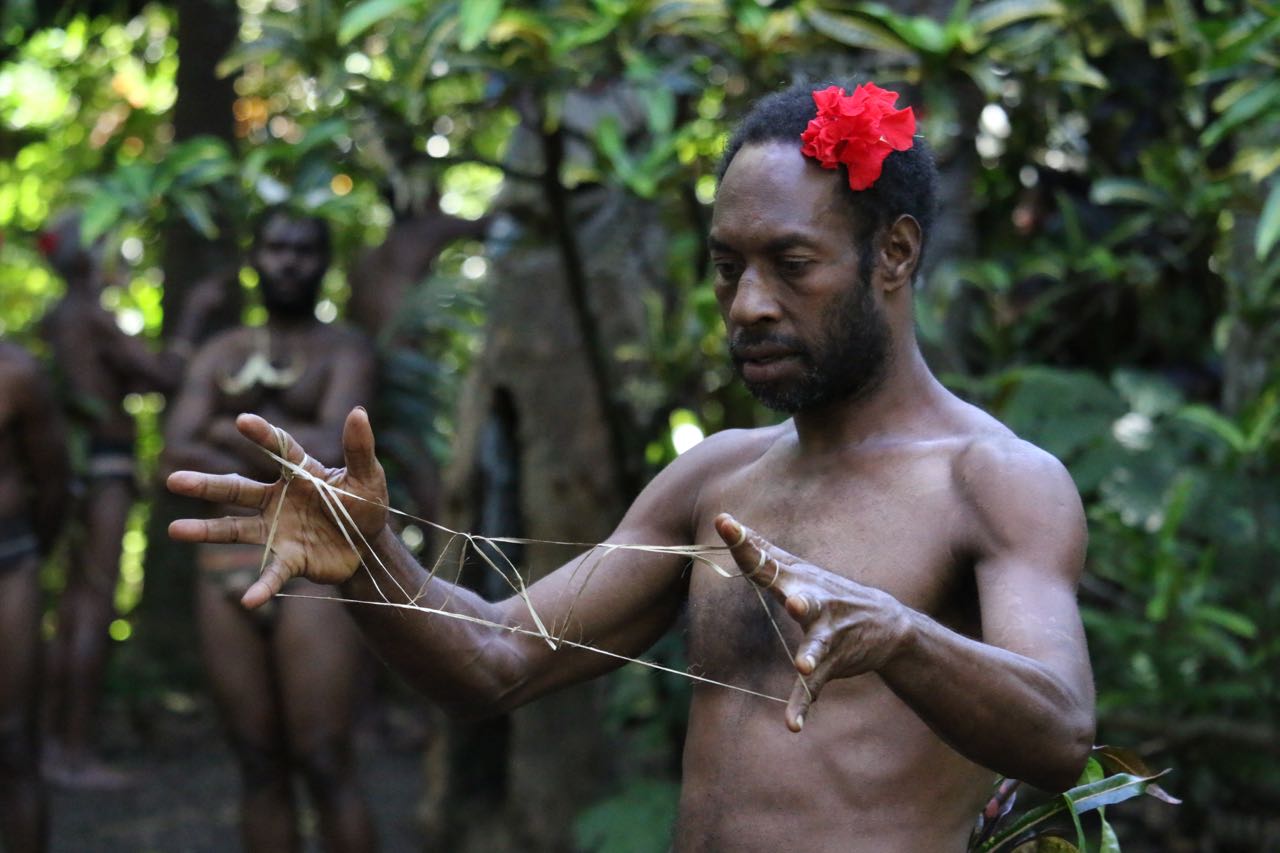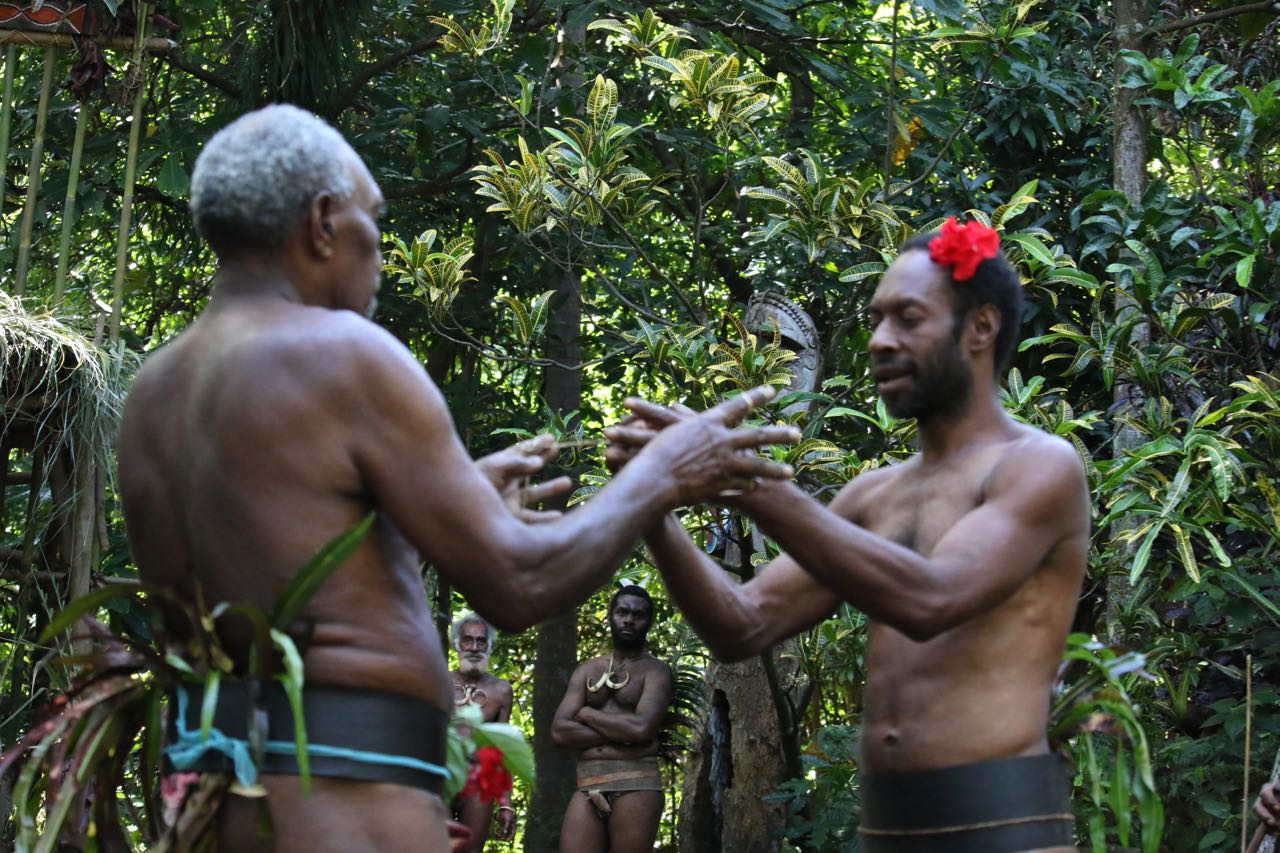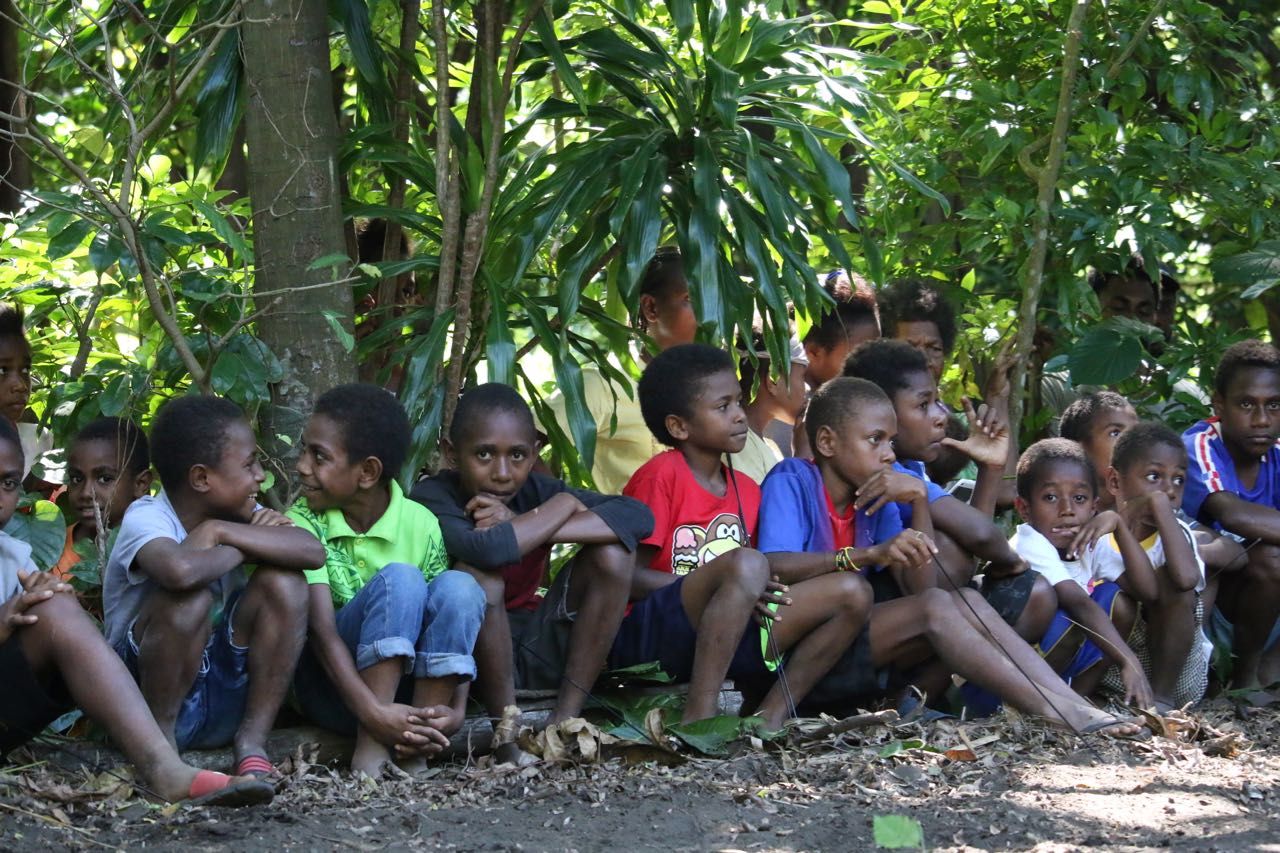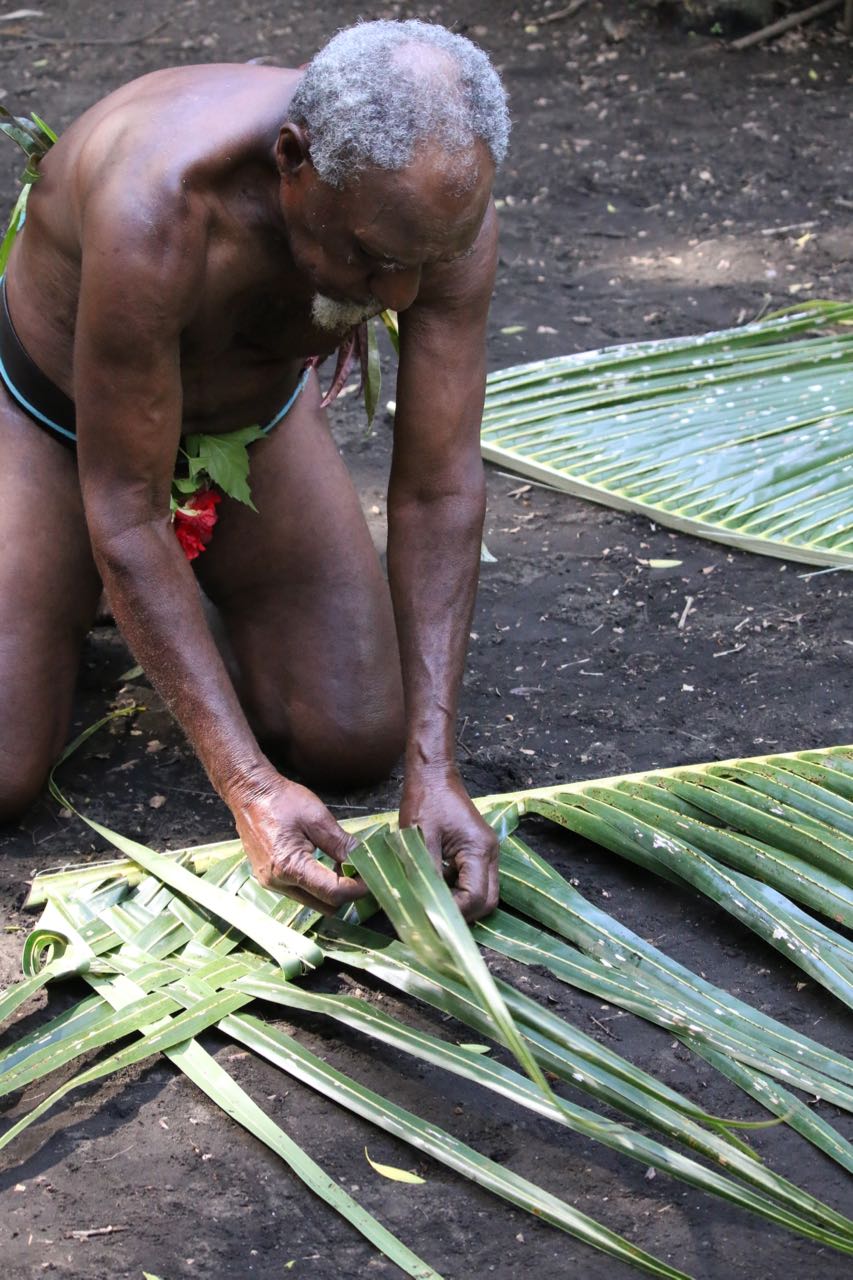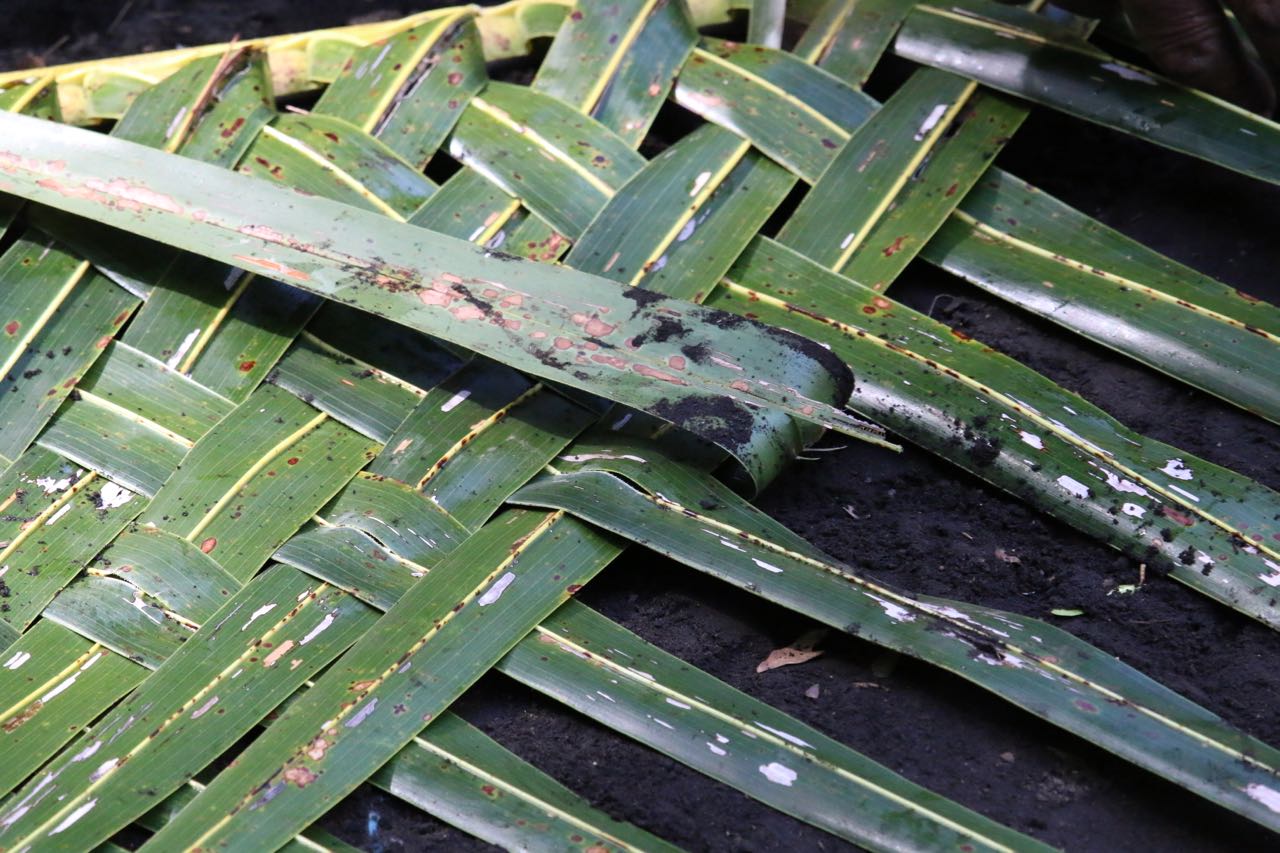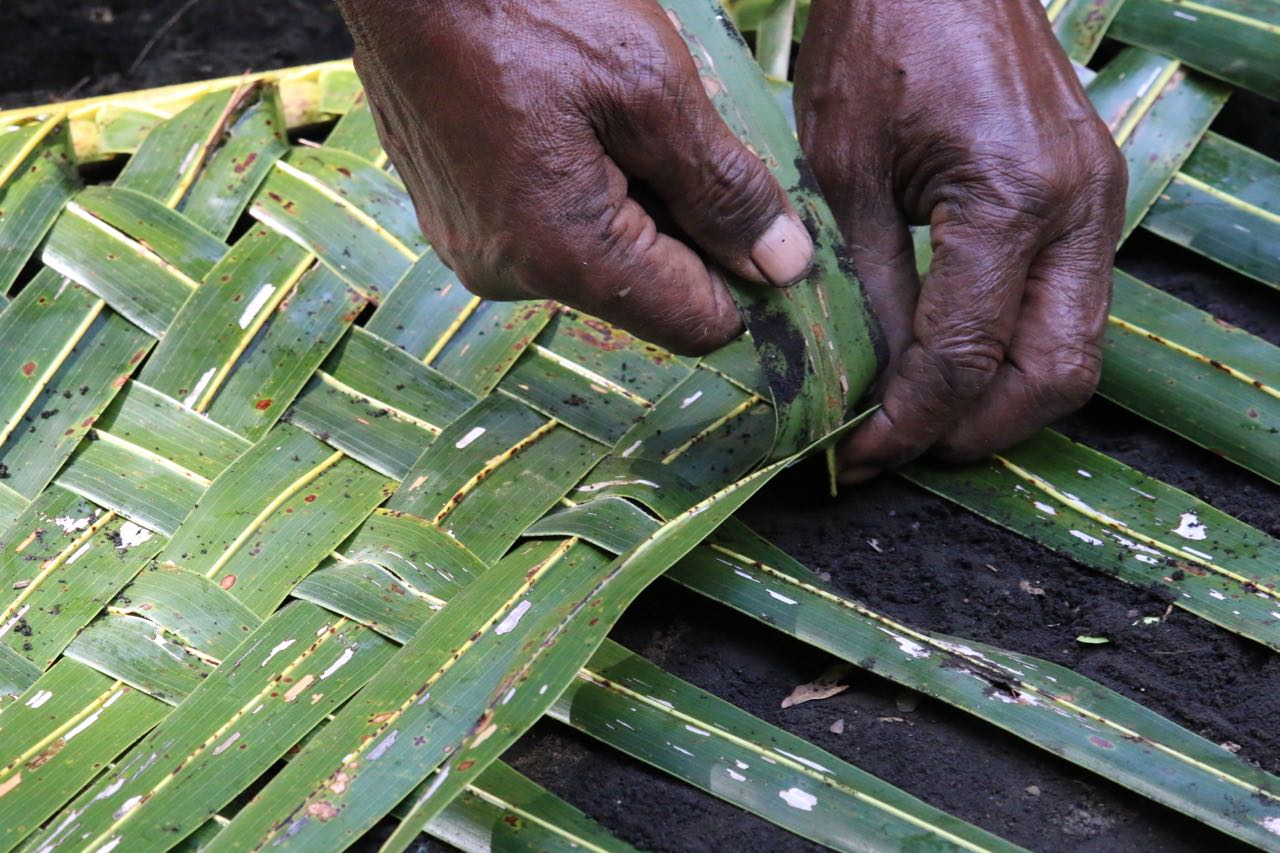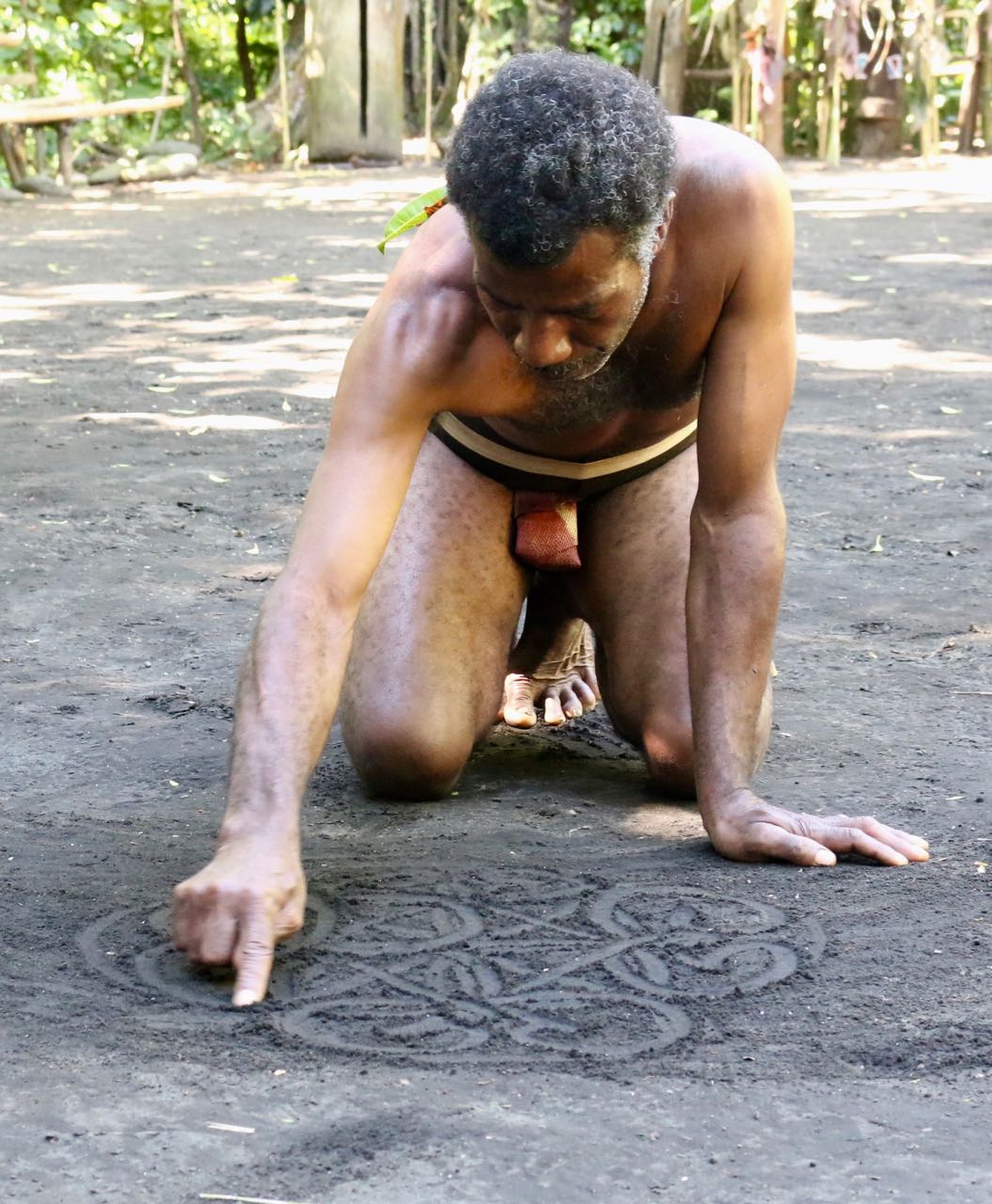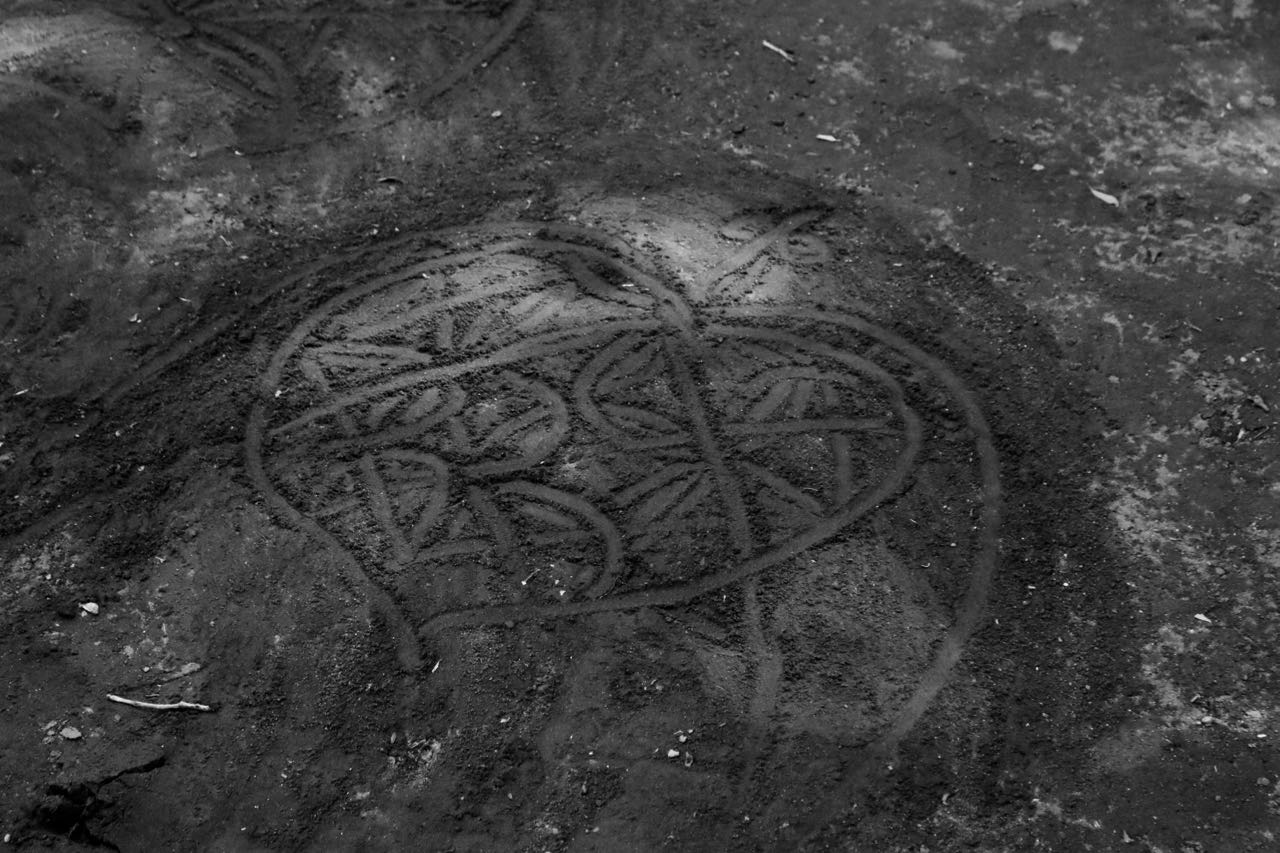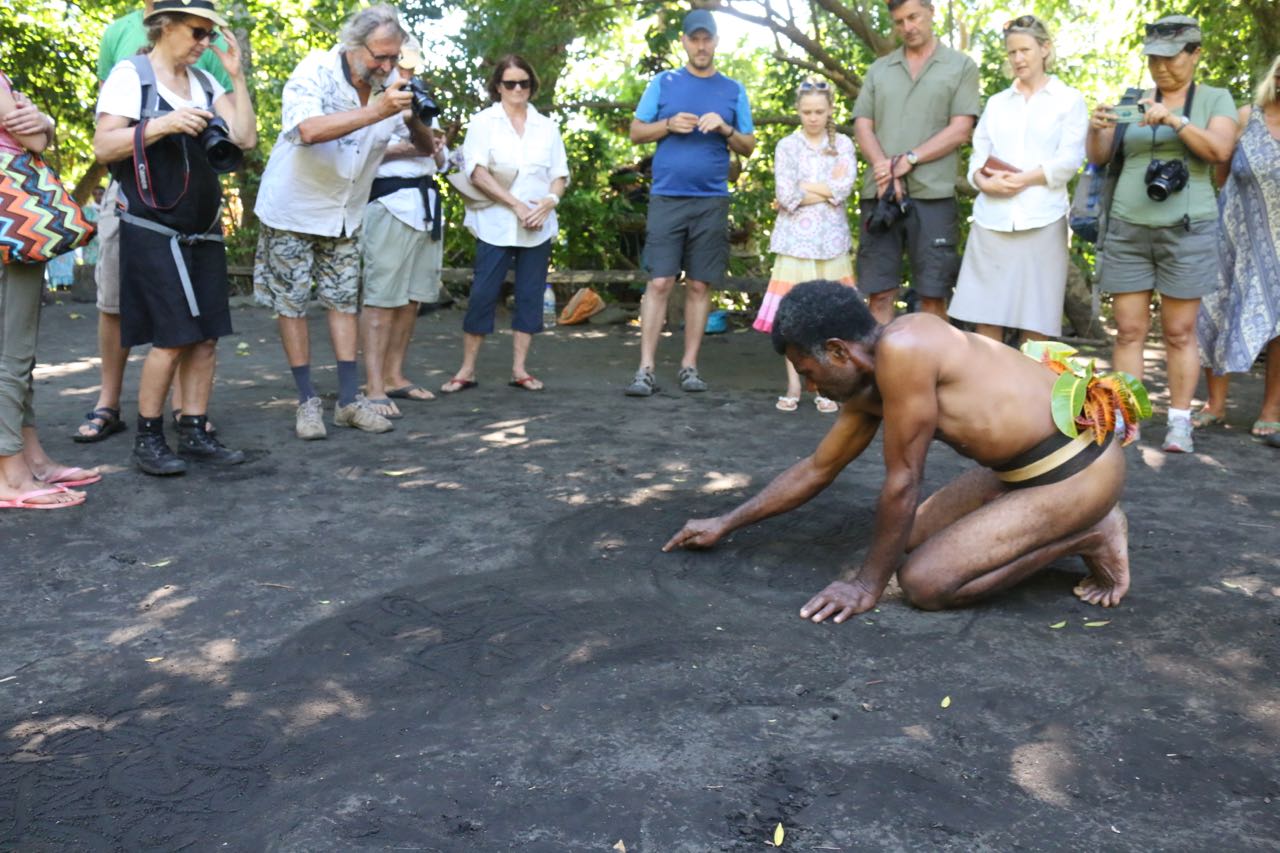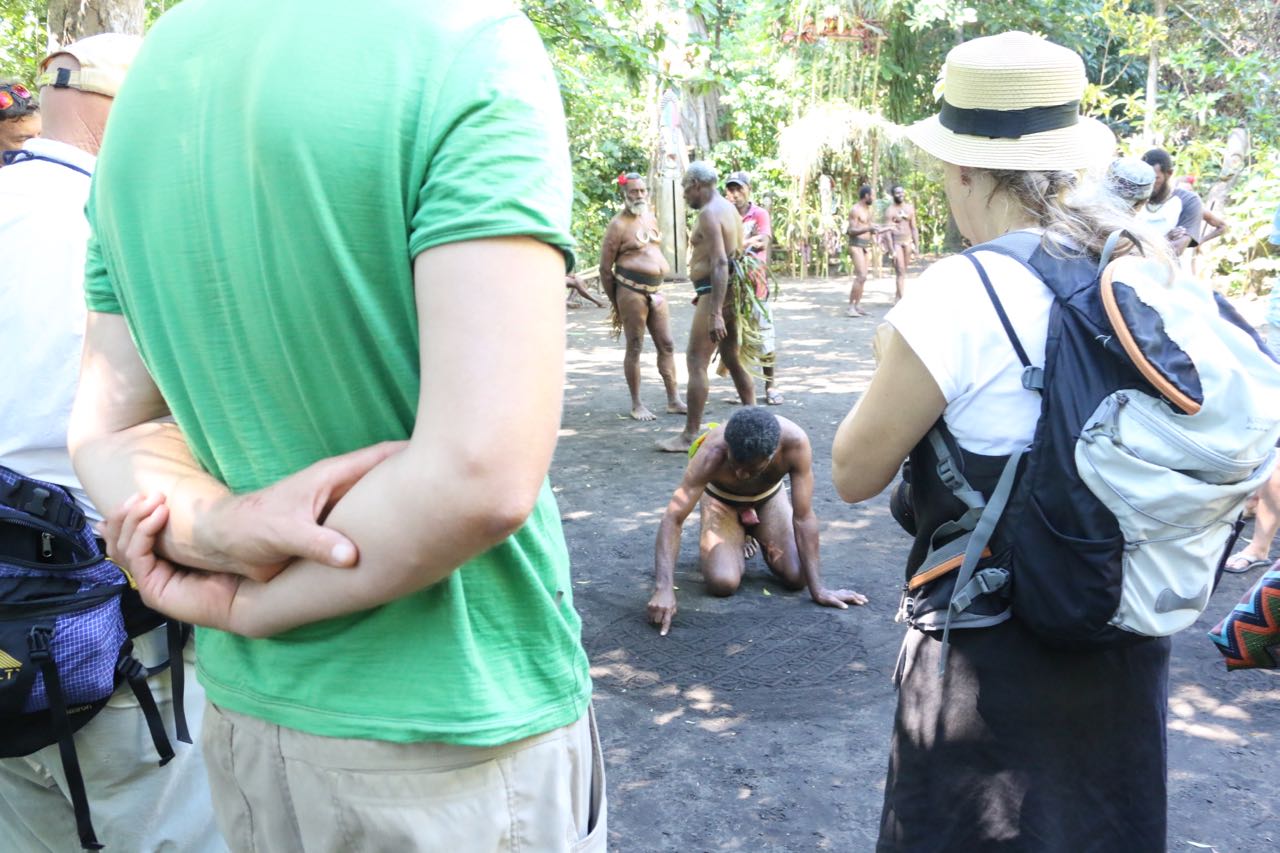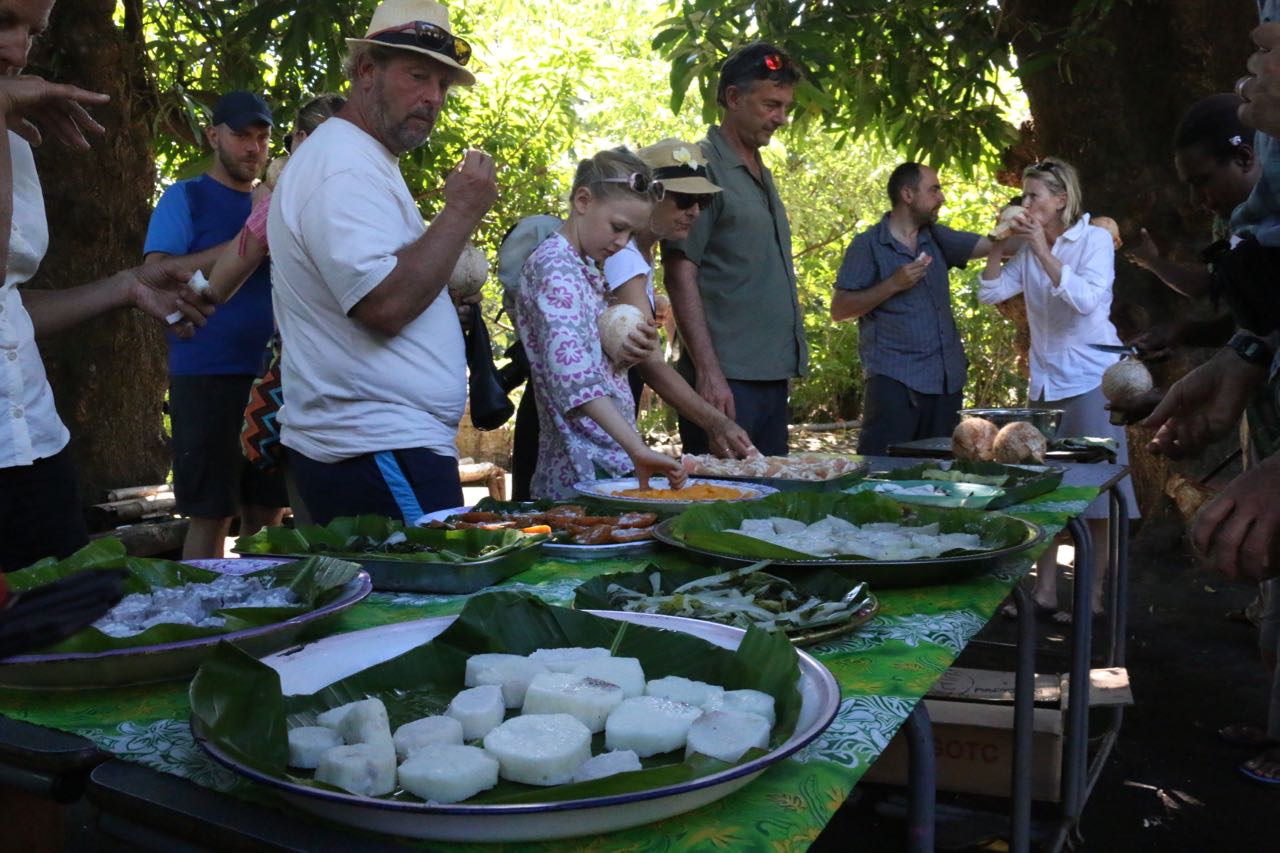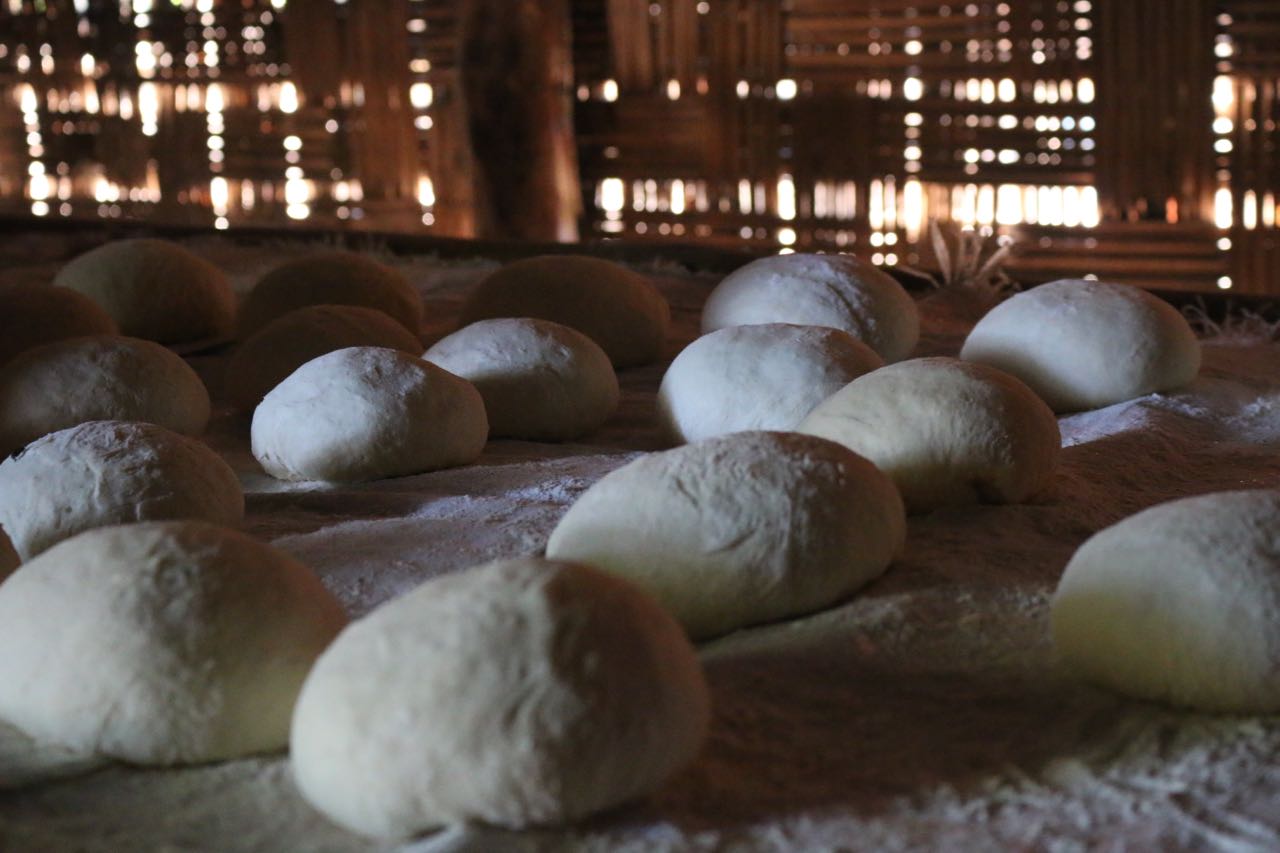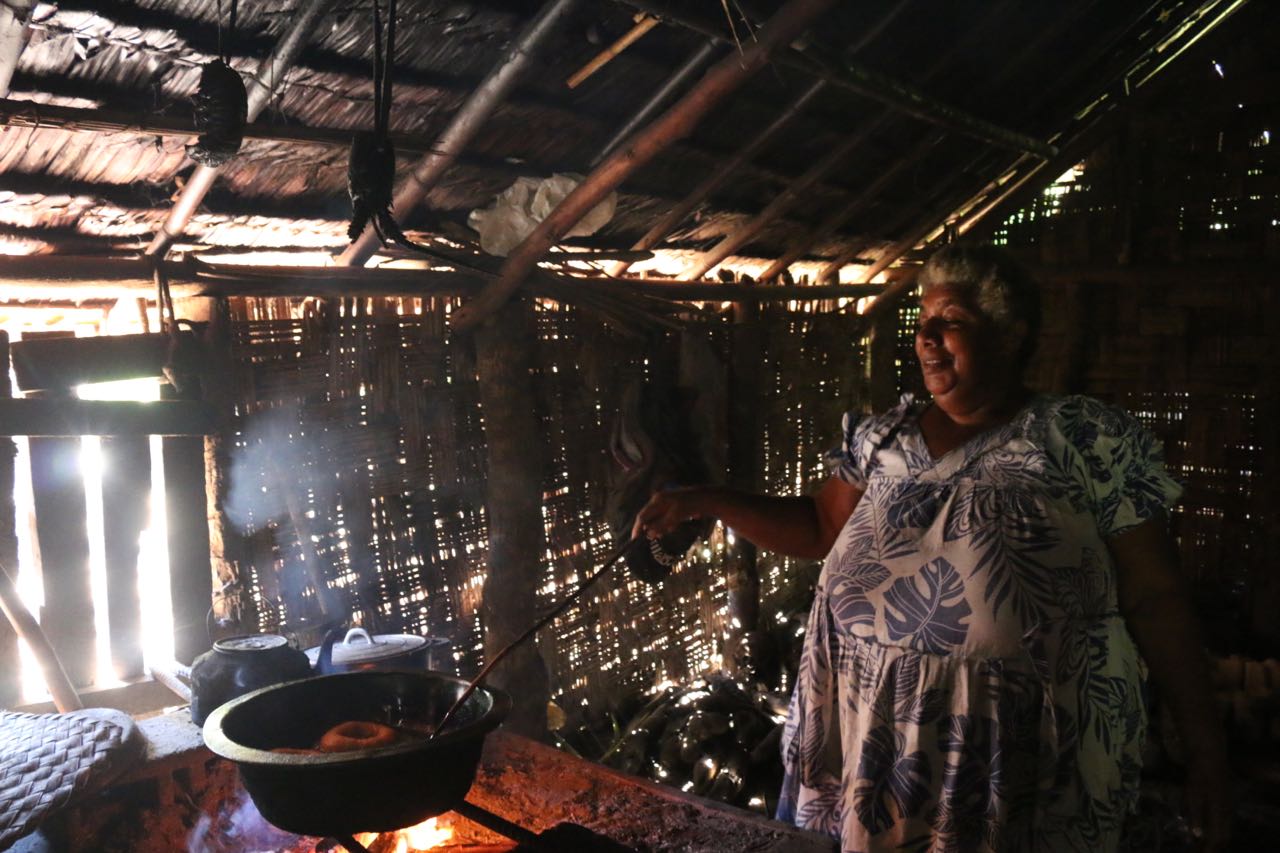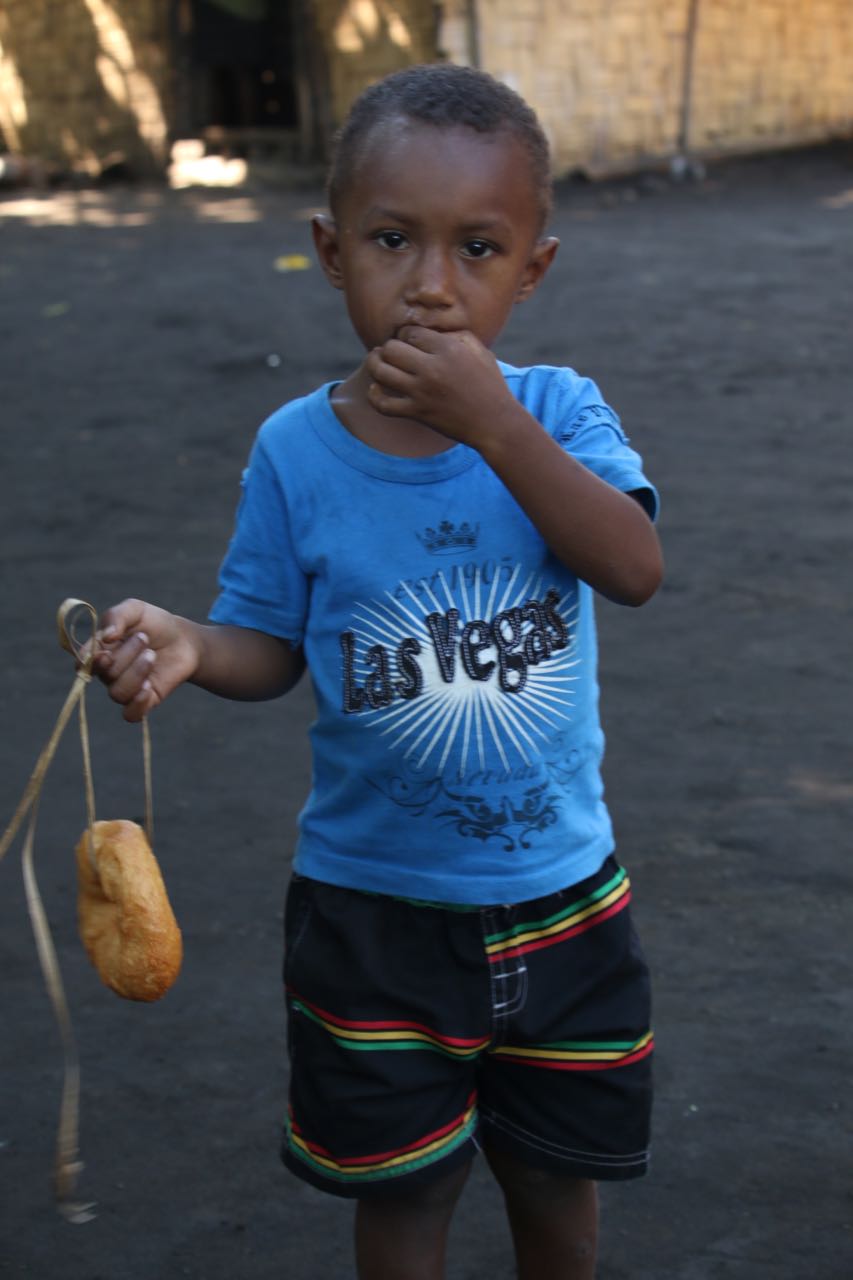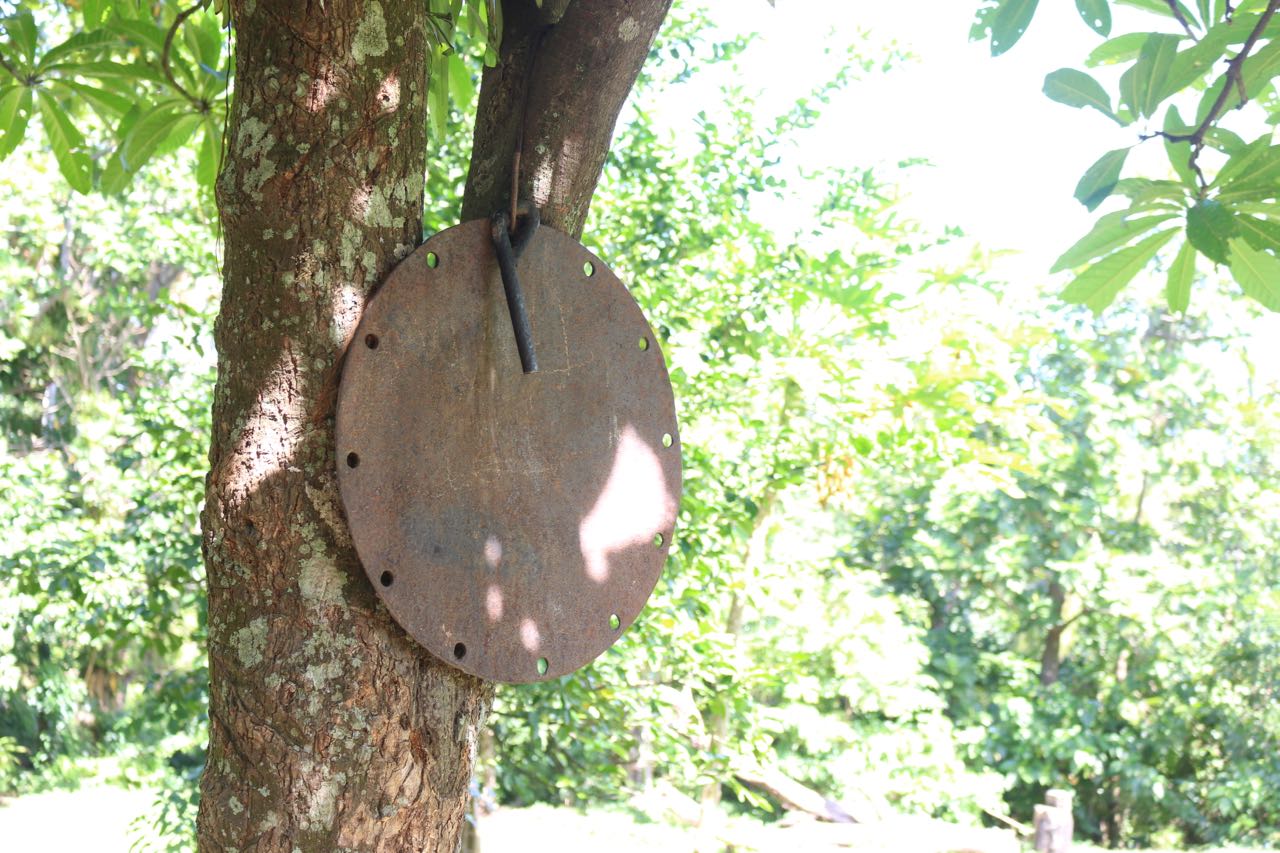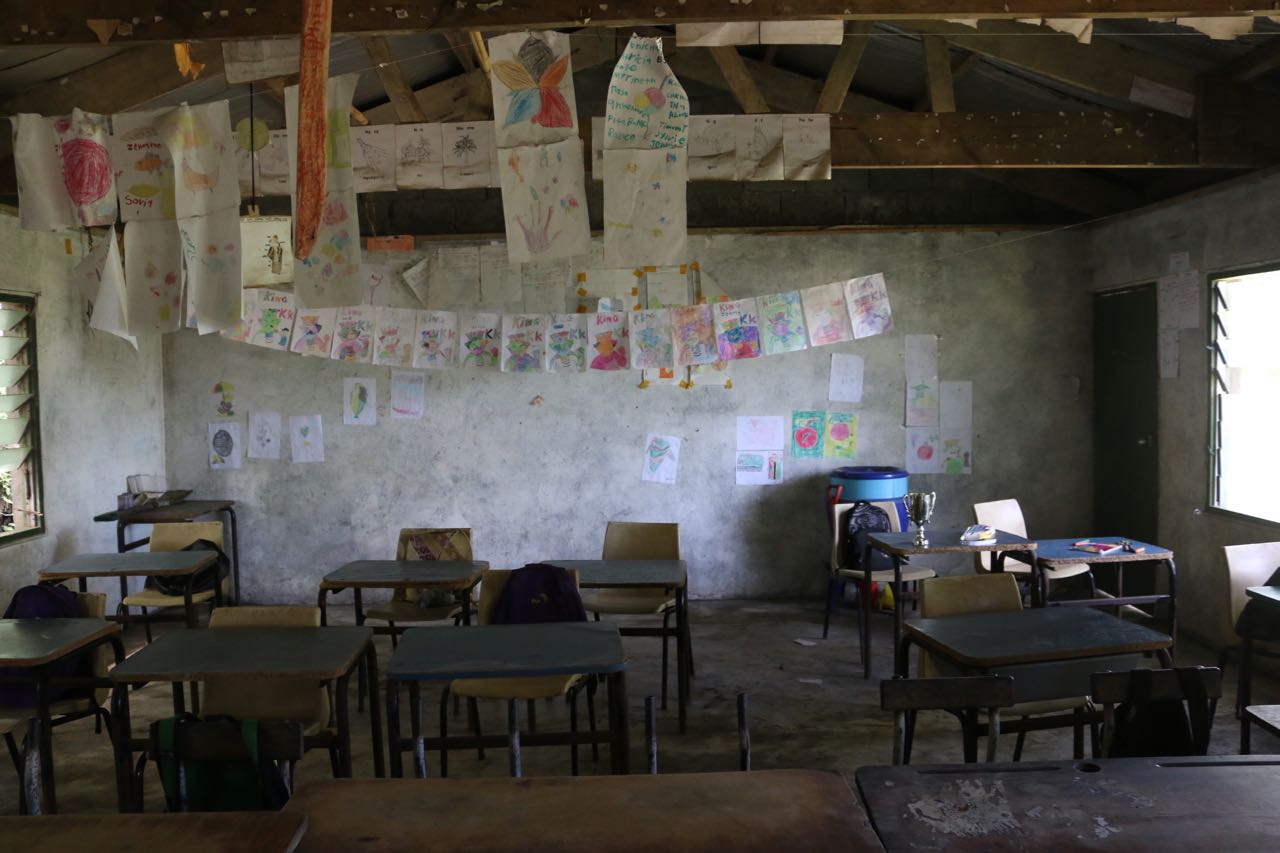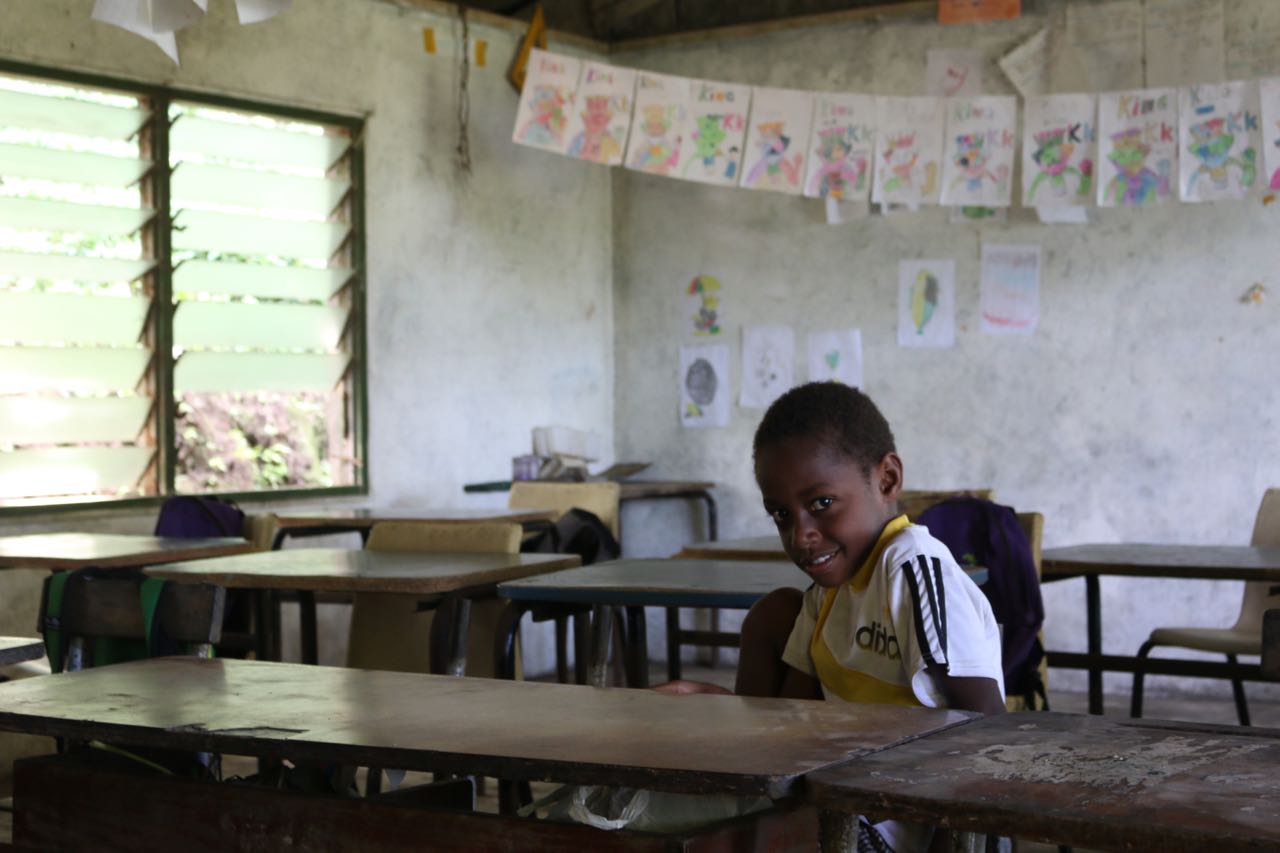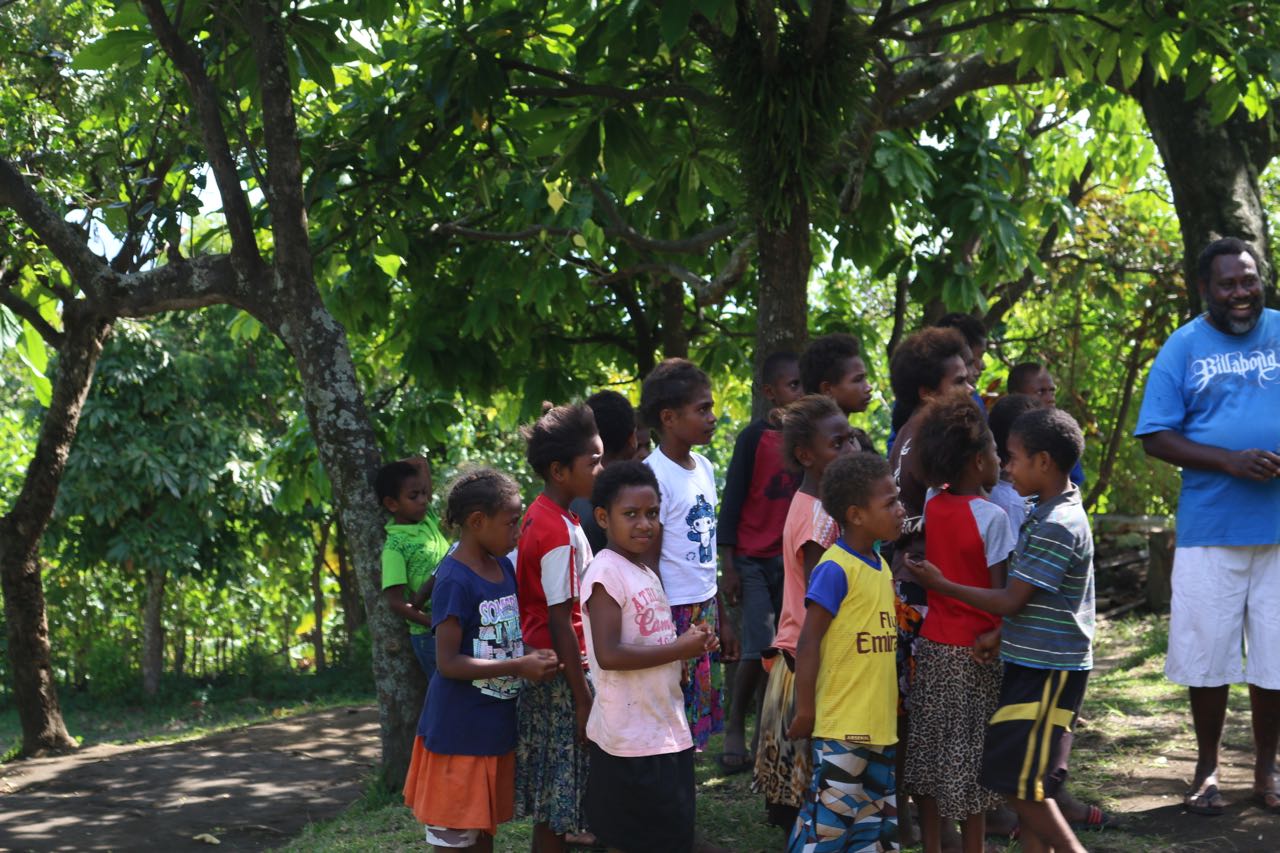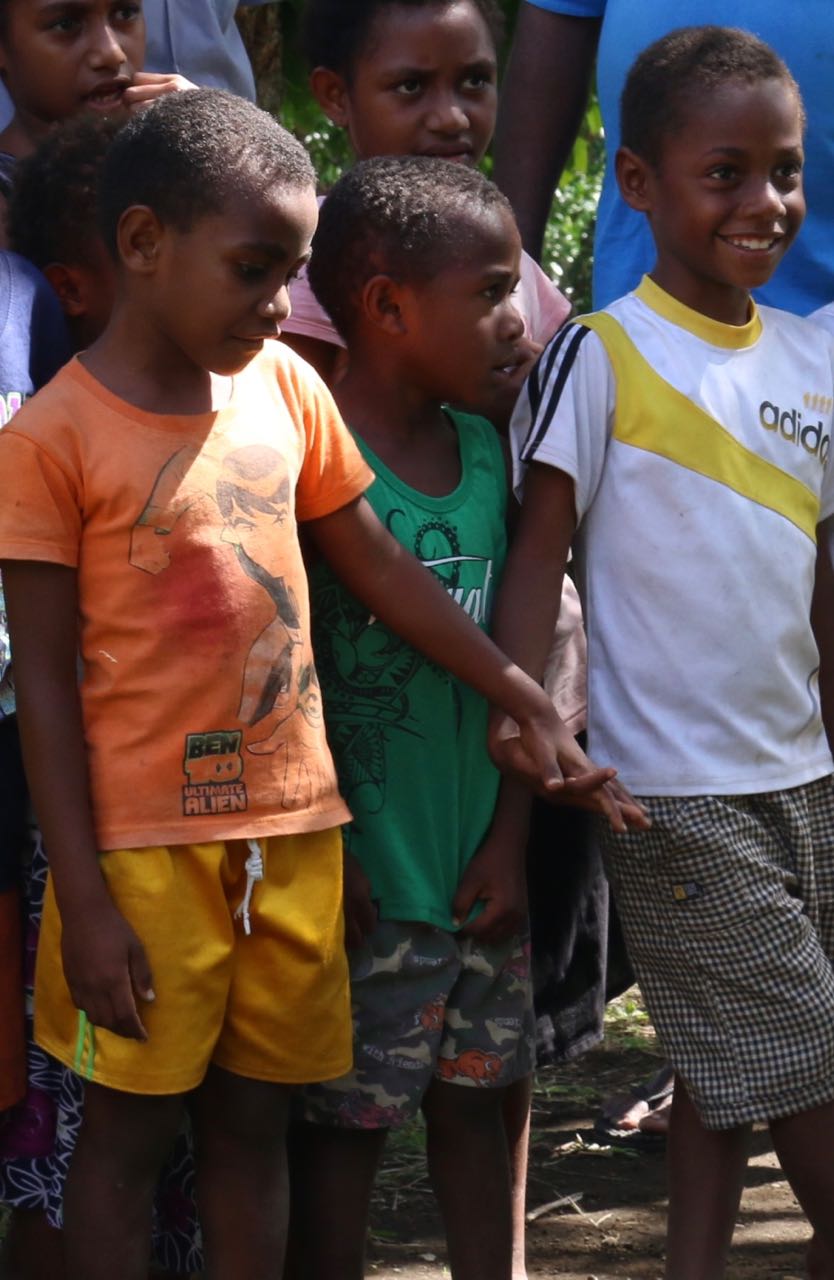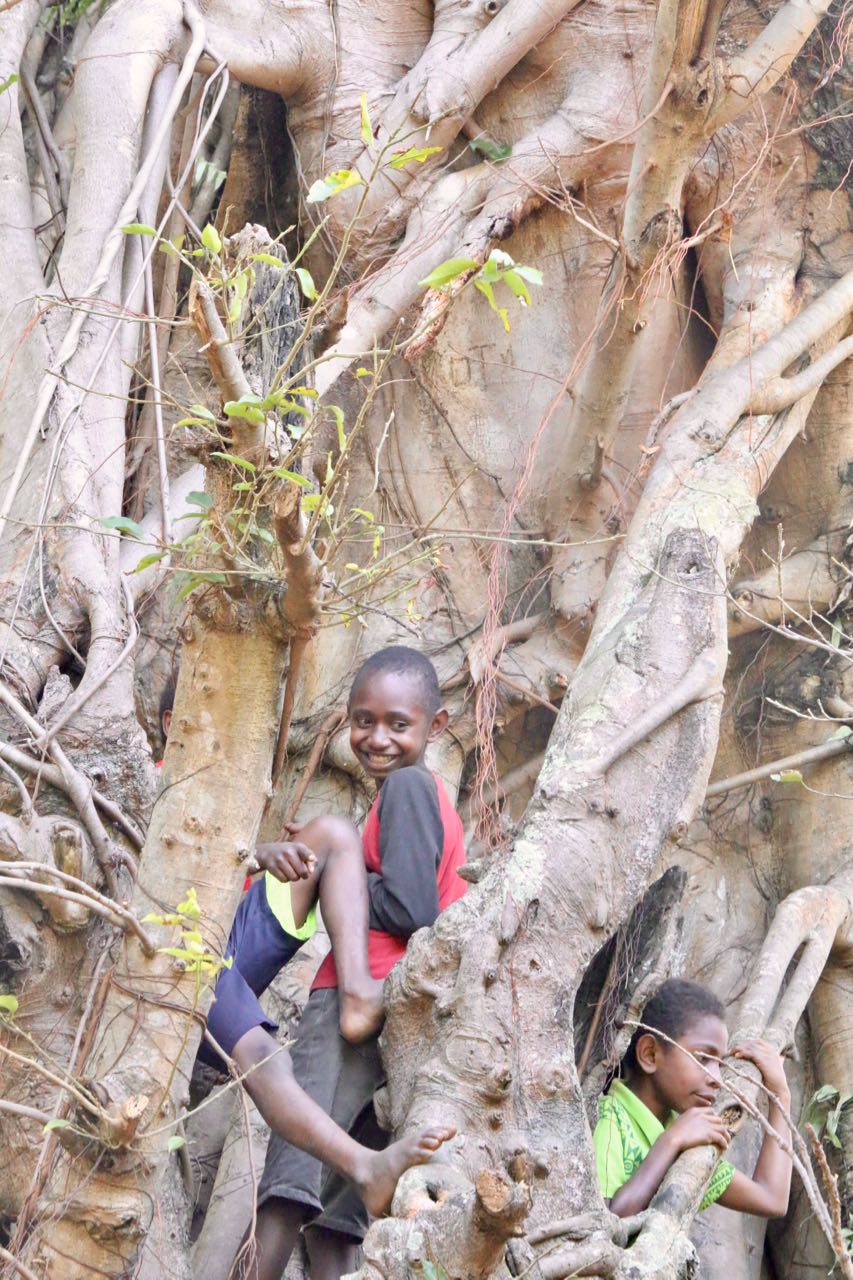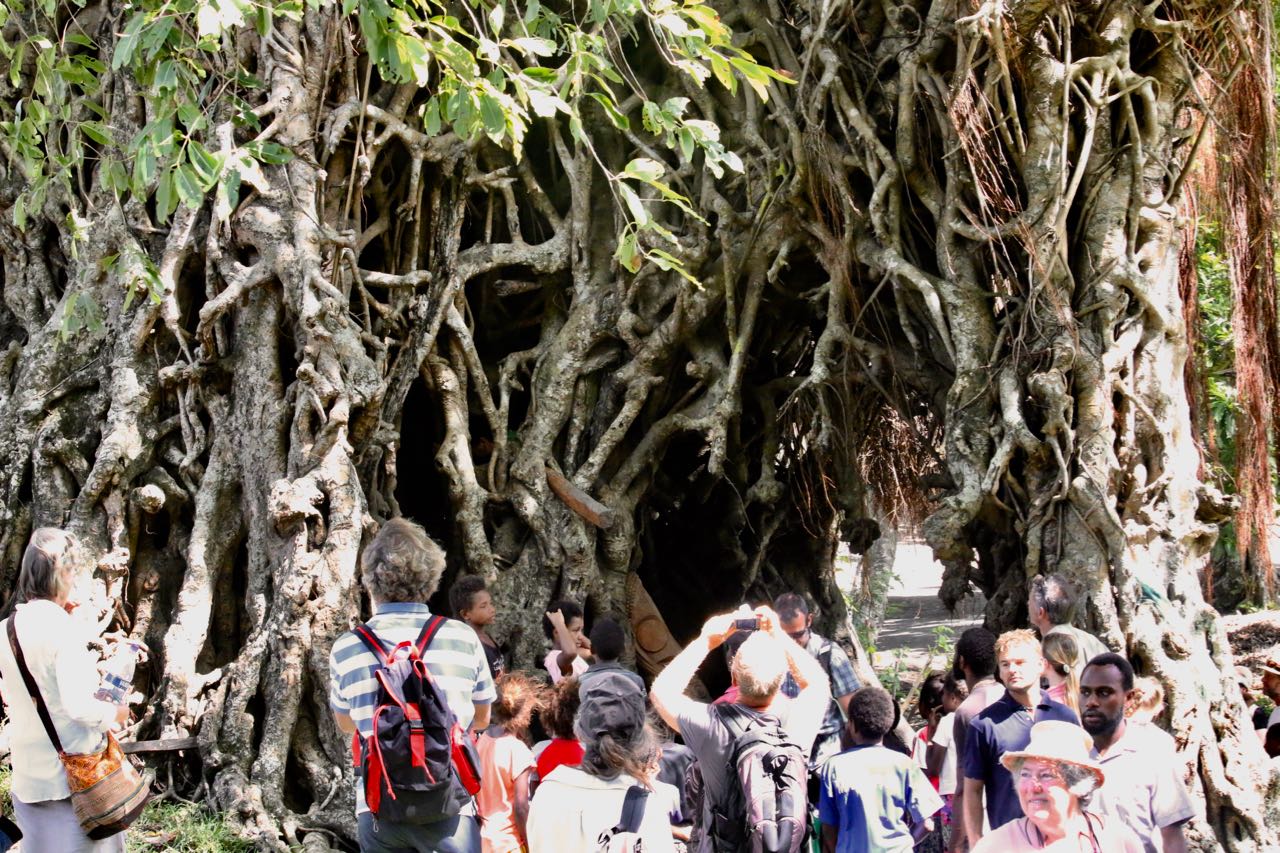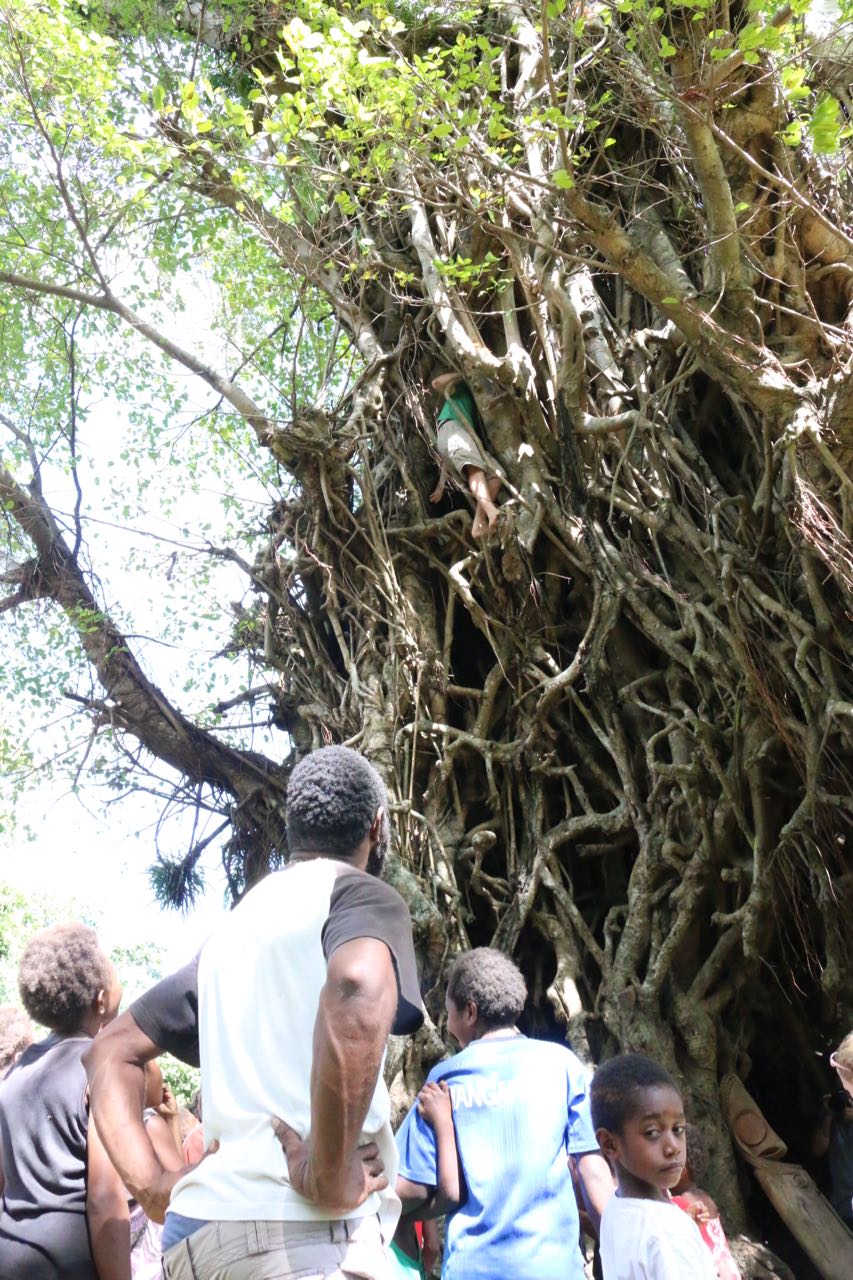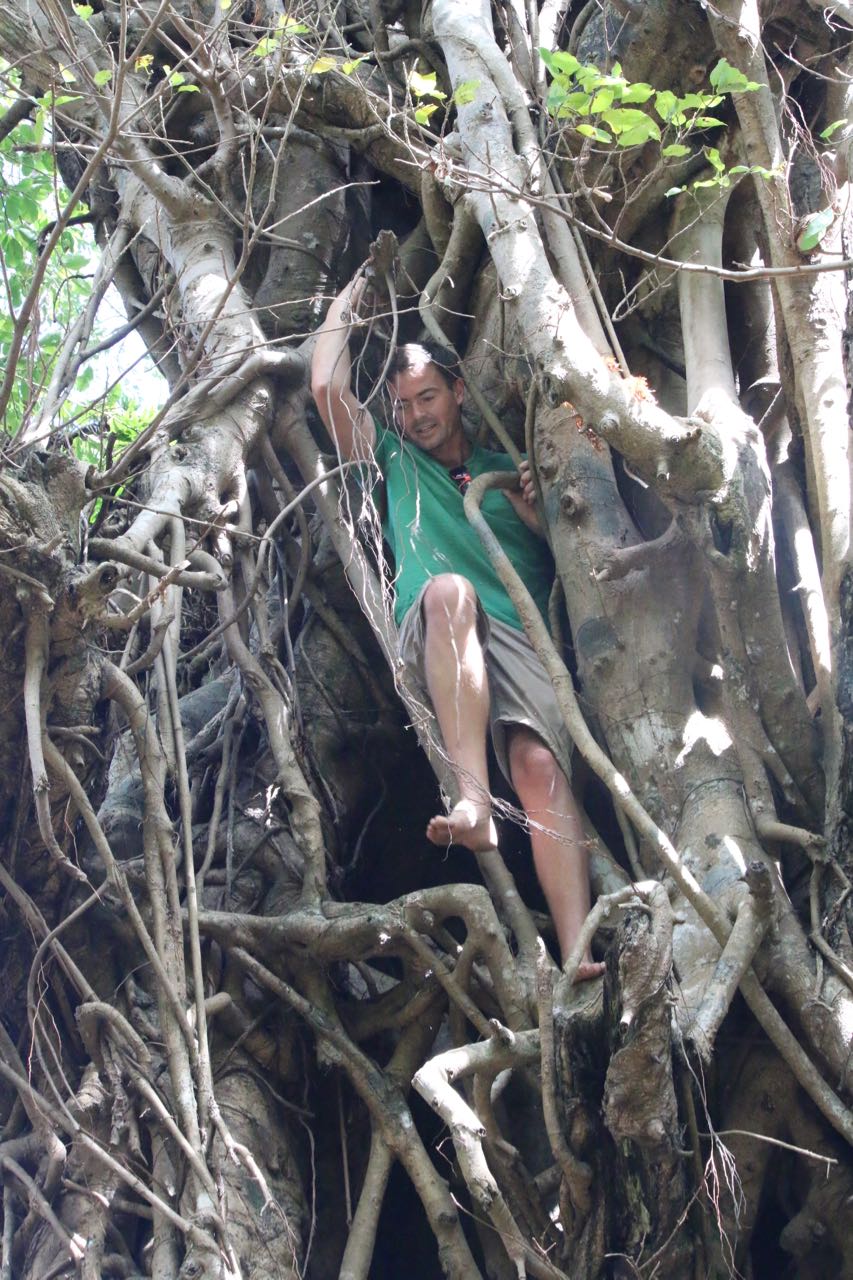I am standing at the bottom of an enormous banyan tree with a group of 30 tourists and again as many Ni Vanuatu. In ten different languages, these people are chittering and pointing into the sky. The Ni Vanuatu guide shouts up instructions, asking some small children if they will show the way. Fifty feet in the air, my husband dangles by his head from the twisted roots of the tree. In this moment, I think “How did we end up here?”
As usual, we sailed. We spend our 87th night at sea sailing from Luganville to Ambrym. We are here to see another yam harvest festival. Given “Ambrym” means “yam” in their village language, we have high expectations.
Our home for the next few days is beautiful. Sonrisa sits in calm waters offshore a black sand beach. The water is so clear, you can easily see Sonrisa’s anchor nestled in the crushed grains of ebony volcano pumice. At night, two live volcanos puff a brilliant red glow at the crest of jungle covered hillside. We wander through the village; get familiar with our new neighborhood.
With this scene, Andrew can’t wait to go for a swim. We drop Sonrisa’s stern ladder and pop in for a dip. Sand eels slither upward, waving in the surf like seaweed until they notice us swimming above them. Then, they slink back into their hole. Besides the sand eels, nothing else is around. No little fish, no clams, no coral, and most tellingly, no locals. There is not a single Ni Vanuatu playing in the water.
From hundreds of feet away, I can see Andrew in the water. He’s diving down, and inspecting the eels. I’m trying to get a bit of a workout, so I swim a steady pace toward shore. Soon, I see a few locals standing on the beach, pointing. I look around to see why they are pointing, but I see nothing. They seem to be pointing at us. I pick up my swimming pace, and Andrew follows me into shore.
An older man, Eddie, saunters down to the waterline. He shakes our hands and chats for a minute with Andrew. Then he says, “You probably shouldn’t swim in the water. We have seen a 7 meter shark here the last few days.” I do the “seven meter” math conversion in my head….21 FEET! I am swimming with a 21 foot shark!?! To put this in perspective, Grin is only 3 meters. I am swimming with a shark TWICE AS BIG AS MY DINGHY!? I look back toward Sonrisa who is now quite a distance away.
“Pssst! Grin! Come get me!” Using my best mental telepathy, I beckon Grin. But he is still lashed down and napping on Sonrisa’s cabin top. Rats. Eddie breaks off two large palm fronds and hands one to each Godfrey. “Take my canoe back, and then you can return it this afternoon.”
I’ve been hoping to take a ride on one of these canoes, so this is a happy opportunity. But there is only one canoe. And what is one of Leslie’s Rules for a Happy Marriage? Never ride a tandem push bike and never, ever paddle a double canoe with your significant other.
Eddie motions to a young man standing back in the jungle who responds by taking up the canoe and dragging it into the sea. I look at the palm frond in my hand, making a paddling motion with it. Eddie nods. “Okay, where do we sit;” I ask, looking at the canoe “on the cross bridge?” Eddie confirms this and I climb aboard a little uncertain.
The canoe is very stable with it’s outrigger log positioned like a catamaran. Maybe if we were cat-sailors we would be better at this. We begin paddling toward Sonrisa with our palm fronds. The canoe moves left. We swap sides we are paddling on but the canoe just moves more left. Soon, we have turned a full 180 degrees and we are facing back toward the beach. We paddle furiously, trying to get the canoe to turn again, but instead we slide along parallel to the beach.
“Maybe we have to turn our bodies around?” Carefully, without falling in or tipping the canoe in shark infested water, Andrew and I flip our bodies the opposite way so we are now facing outward to Sonrisa again. We paddle. The canoe turns another 180 degrees. We both scowl. “There has to be a trick to this.” I start to giggle.
Now, a group of locals have gathered on the beach to watch this adventure. But they aren’t laughing, they are watching us with completely puzzled faces that read “What is wrong with these people?” Eddie gives me a paddling motion in the air, and I think how helpful he is being. Andrew flips his body back around so he is now facing forward, the palm frond splashing water back upon me and into the canoe. We probably should have swam back. All this “paddling” is going to attract our shark!
I begin to turn back around, but Andrew says to stay as I am. “You can paddle when you are facing forward, and I can paddle when I am facing forward. This makes me giggle more, and it calls to mind a photograph we have of us paddling a canoe in Maine, circa 2008.
Andrew grabs one of his swimming fins and paddles with one fin and one palm frond. He tows me along facing backward, giggling for two or three strokes until the canoe turns 180 degrees again. I take up the mantle and start paddling with my palm frond, but soon we are turned the other way again. I cannot stop laughing. I picture myself standing on the beach with the locals watching two crazy Americans turn circles in this canoe. Each time I am the lead paddler, I look toward Sonrisa and I swear I can see a mix of concern and embarrassment on her face.
Loop. Loop. Loop.
“We are getting towed away to sea!” I cry out, laughing, the current flipping us around in a circle again.
At this point the locals are disbursing, shaking their heads. These people sail and paddle these canoes fifteen, thirty miles a day paddling or sailing them from one island to another to plant gardens, trade with neighboring villages, meet with friends. We are paddling in circles 500 yards from the beach. How is it possible that we have survived 11,000 miles at sea?
Eventually, we circle up next to Sonrisa’s bow, and I’m still laughing. We roust Grin, who takes an immediate liking to his new friend. Using a two sided paddle, Andrew paddles a crooked line back to shore. I follow behind in Grin.
Over the course of the day, more and more sailboats arrive. We were the third boat in the anchorage, but soon we have ten. When the French boat arrives, the crew strips down naked and jumps in the water. “Should I go tell them about the shark?” Andrew asks, then answering his own question he says “we probably should.” He putters over in Grin. Discovering they don’t speak much English, he uses hand signals and pulls the word “Ringcoon” out of the recesses of his questionable French vocabulary. Though the French word for shark is “requin,” “ringcoon” was apparently close enough and the naked Frechmen climb out of the water.
Andrew is now the anchorage bearer of bad tidings.
The next morning, a flotilla of dinghies head to shore at 8:00 a.m. sharp. The truck we ordered to take us into the mountains to the village of Fanta arrives; the bed still dripping with the blood of a ceremonial cow. “Don’t worry,” our guide, William, says “we are just going to go wash the truck and we will be back.”
Twenty-five sailors and two Czechoslovakian travelers wait. Some of the sailors are getting antsy. “We ordered the vehicle to be here at 8:00 a.m., the show starts at 9:00 a.m. and it is 8:40 a.m.” There is a measure of pouting. When William returns, the German and French contingent climb into the back of the truck, leaving the Americans and the Kiwis behind for the second wave. Pouting heats up to grousing. “Don’t worry!” William says as the truck sputters off in a cloud of dust.
We wait. Andrew and I have been sailing long enough to know we probably aren’t going to miss anything. “I doubt they will start at 9:00 a.m.; in fact, I bet they will wait for us.” I say, uncharacteristically calm about the potential of missing out on yam-festivities. A half hour later, the truck returns, eight of us squeeze into the bed, two into the cab. I get the prime uphill seat, my back to the tailgate, my feet braced against the wheel well. I pose ready to catch any of the six sailors upwind of me in the cushion of my lap.
The truck bounces along a rutted beachside road until it makes a curve, straight up the side of the hill. The driver stops on a steep incline, grinds the gears into four wheel drive, and adeptly releases the clutch to regain forward momentum without rolling backwards down the cliff. I am grateful for his competence. The exhaust of the Toyota Land Rover growls deep in the truck’s belly. We rocket straight up the cliff, touch the peak, then rumble and roll down the backside. The road is nothing but deep ruts in the jungle grass. Andrew, who had taken the standing spot front-center of the truck, is now ducking and dodging tree branches overhead. He looks back at me at one point, beaming the smile of a twelve year old boy. “Its just like Indiana Jones at Disneyland!” He exclaims.
We arrive at the village to find all the other sailors waiting in a row of chairs. William explains now that we are all here, the festival will start in approximately fifteen minutes. He will return and fetch us when everything is ready. Everyone breaths a sigh of relief that we haven’t missed the show. We settle into our chairs, enjoying the shade of a breadfruit tree. Village children play in and amongst us, the women chat with each other in the village language, watch the children, peek over at us.
Soon, William returns and makes an announcement that all is ready. We must go to the “sacred-secret place,” but we cannot enter until he gives us the all clear. He leads us through the footpaths of the village. As we near the clearing, we can hear the deep hum of the elders singing, the rhythm of their feet stomping a slow beat. William tells us we can peek through a row of plants lining a square clearing, but we cannot enter yet. The dance being done is sacred, and it is readying the dancers for their duties.
When we are welcomed into the “secret-sacred place” we sit on benches lining the area. Tourists and local villagers alike gather around with cameras, phones and pads.
We watch dancing, drumming, a demonstration of custom story telling methods including both sand drawing and the making shapes using long strands of grass.
We are offered lunch.
I peek into the cooking hut to find Mama frying donuts to share.
We are given a village tour where see the school and the school kids sing for us.
Then, we are shown the village playground, i.e. a giant Banyan tree on which the kids love to climb. With roots growing fifty feet in circumference, the tree is tall and mighty as a sky scraper. I am merrily clicking away with my camera trying to capture the size of the tree and the children sitting casually thirty feet in the air, when a crowd draws closer to the base of the tree, fingers pointing skyward.
I rotate around to the other side, look up, and briefly see the a flash of a green t-shirt moving slowly upward on the inside of the tree’s roots. It’s a large green t-shirt. Much bigger than the child sized t-shirts I had previously seen clambering their way inside the tree.
Andrew.
Andrew is inside the tree, climbing up and up and up.
At first, everyone is amused that a fully grown American man is climbing the tree. He finds a perch, looks out at me and smiles as if to say “Look at me! I’m in the tree!”
Then, he looks down. He looks down at his feet inside the tree where he climbed up and realized while he is unlikely to fall down through the roots, they are so tightly woven it is unlikely he will be able to make his way back down without becoming tangled. He looks down on the outside of the tree and realizes he is quite high up, and on the outside, free to fall. Hmmm.
Now, all the Ni Vanuatu can see he’s a bit stuck. These people are some of the most hospitable people in the world, so there is always great concern for the safety of their guests - even if some of the more traditional safety measures are not employed (i.e. preventing the climbing of the giant tree in the first place.) Concerned faces of village women look back at William, our guide, hoping he will help Andrew out of the tree.
William calls up to Andrew and instructs him that he will have to climb down the outside of the tree. Andrew looks down, uncertain. How exactly is he going to squeeze out from inside the tree to the outside?
“Climb down on the outside!” William calls again. “Can you squeeze through and climb down the outside?” We all wait, Ni Vanuatu faces turned skyward, watching Andrew make tentative attempts to get his left foot outside the root tangle.
In his village language, William calls out to the children climbing in the tree who deftly weave their way through the tree to where Andrew is, squeeze outside of the tree and show him the way down. Andrew watches, receiving instruction.
“Follow the kids down!” William calls out. I can hear a bit of concern in his voice now.
Andrew gets his gangly legs pointed toward the outside the roots and they slide through an opening just wide enough for his hips. But then, his shoulders get stuck. He has no choice but to stick a foot upward and brace against the roots to unpin his shoulder and twist himself around to squeeze out. It isn’t a pretty sight, but we are all riveted by the drama unfolding. It’s like a train wreck. You can’t look away.
Suddenly, his shoulders become free, his feet are free and the only thing trapped is his head. His head is squeezed between two roots twisted into a point. Andrew scrunches his face with pain, his hands are still hanging on, but his feet are running to grab purchase on open air. It looks like his head is stuck! I consider squealing “DON’T DIE! DON’T DIE!” as I have in the past, but instead, I distract myself by taking photographs of Andrew’s misery instead. Soon, he regains purchase with his feet and pulls outward with his head and neck.
“No! No! Go down a little bit, go down a little bit!” William says. William can see what Andrew cannot. If Andrew can reach his feet downward just a little bit, his head will come through a wider spot in the roots and he will be free. Six feet three inches of Andrew reaches from trapped head to tippy toe just long enough to find a root to step on. He lowers himself downward and suddenly his head pops free.
William heaves a sigh of relief and all the Ni Vanuatu begin clapping as Andrew climbs down.
As we walk back to the sacred-secret place to finish off the day with the revealing of the Rom Masks for tomorrow’s dance, Andrew rubs a sore spot on his head. “I didn’t expect to be re-birthed by a tree today!”



